#this article describes to a t the relationship i have with making art
Explore tagged Tumblr posts
Text

“just because you feel awful doesn’t mean you’re doing it wrong” // jane elliot
#this article describes to a t the relationship i have with making art#and i have to say im kinda really proud of myself? that ive had this relationship with it for YEARS and i still havent given up on trying to#make it yourself#and very veeeery slowly i think im finally cracking trough that fence#anyway i do recommend this article to anyone struggling with internal resistance#reading logs#mental health refs
8 notes
·
View notes
Photo

Diaspora Aesthetics
African Diaspora in the works of Aaron Douglas, Jacob Lawrence and Jean-Michel Basquiat (Lemke, 2008) is an article, in the book: Exiles, Diasporas and Strangers (Mercer, 2008), that aims to investigate what diaspora art looks like and can be characterised by. The writer, Sieglinde Lemke, does this by evaluating three artists’ work (named in the title) and visually analysing how they link to diaspora.
Throughout the essay, the writer explains that diaspora art in general serves to unite people. She compares the work of R.B. Kitaj’s First Diasporist Manifesto (1989) and Stuart Hall’s Cultural Identity and Diaspora"(1990). She finds that both reject a “backward looking conception of diaspora“ (Menke, 2008) and believe that diasporic art aims to affirm the diasporic identity. From this statement, it can give off the impression that the imagery of the paintings will be positive and welcoming as unity is synonymous with cohesion and totality. Key fundamentals that are observed by functionalists. However, Kitaj says how the diasporic life is defined by “transient restlessness, Un-at-homeness and groundlessness”( Kitaj, 1989) and Hall describes the black diaspora being characterised by its “hybridity, contingency and diversity” (Hall 1990). Despite seeming to contradict themselves, they mean that by creating art work that individuals can see themselves in, even if the imagery represents painful experiences like struggle and oppression, the viewer feels seen and comforted, thus forth “being forward looking” and creating unity.
Early on in the essay, Menke introduces how the homophone of “roots”, “routes” and “riots” are used as key aspects in the diaspora discourse. Clifford (Menke, 2008) observed how by combining roots and routes, produced what Gilroy (1993) called “alternate public spheres”. This was when a “community consciousness” and a community was constructed. This meant that although the individual may feel like they are alienated in the society that they live in, they can still connect to their ancestors and their culture through the art that connects different parts of their culture and community through diaspora art.
One point I personally agree with Menke was when she was discussing Aaron Douglas’ work Negro in an African Setting and quoted Paranjape (Menke, 2008) saying that the the artists represent that the “homeland” is a sort of “sacred site or symbol almost like an idol of memory”.The diversity within different diaspora was acknowledged many times in the
Although I disagree with some of the interpretations of the art discussed in the essay whihc used the the idea of “yearning” which was repeated theoughout the text. These statements give off the impression that there is resentment for the country that the individual lives in. There is the implication that the country the person has ties to is where they should feel belonging but I find that from personal experience and form conversations with other people from a similar background to me that young people who were raised in a country that is different to their ethnicity, experience some sort of imposter syndrome when surrounding by either cultures that are a part of their hybrid identity, so they do not have the same sort of relationship to the “homeland” the essay seems to romanticise. It also makes me think that you must sacrifice one of your collective identities in order to be accepted; however, I do not believe that this is true.
In the essay I would have also liked to hear more about post modern theories in relation to the art pieces. When Menke would use the term postmodern it was usually brushed over. There is a part earlier on in the essay where the author writes about how Locke, one of Aaron Douglas’ inspirations, emphasised in his manifesto the new negro that artists need to use their culture and ancestry to inspire their art, the way that famous western artists like picasso did in order to shape black american modernism. By reclaiming the influences, it allows the “disenfranchised to create their own meta narrative ”(Menke, 2008) . Postmodernist theorists like Lyotard would argue that “meta narratives are breaking down”(Lyotard, 1979). They no longer hold power anymore. This is a result of increased fragmentation of society caused by factors like globalisation. So maybe even if there is a new theoretical meta narrative it may not hold as much power as posed in Menke’s writing.
I do agree with Lyotard that overarching metanarratives do not dictate how people's lives go as strictly anymore. I think that the reason for this is because of the increased access of technology and the internet. This has led to “pick n mix identities' ' (Baudrillard, 1970), since individuals’ consumption are no longer restricted by age, class or gender. Globalisation and glocalisation means that consumers can choose elements of identities from anywhere in the world, this is not just limited to clothes. Diasporic identities can now find communities online. I think there are many more subcultures online than there were when the book Exiles, Diasporas an Strangers was published.
Although I agree with these postmodernist theories, I do not think they always apply to diasporic identities as the theories seem to mostly apply to the west. I think that purely having access to all these types of identities and subcultures does not give someone the privilege to take a part in them and use them as a part of their own identity. For example how Sohelia Sokhanvari presented Iranian women, they in theory could wear what they wanted but, there were consequences to these decisions. Diasporic identities tend to cluster together and create communities. There are many examples of this in London, such as ChinaTown. By growing up in one of these small diasporic communities, I find that the values that are encouraged in the “homeland” are continued on. Like the types of clothing and expectations of “young bengali women.”
After reading this extract, I would like to look more into the history of Bangladeshi textiles and also the concept of primitivism that was mentioned in the book. Where cultures that did not resemble the west, are looked down upon. I have experiences where people would make remarks such as comparing acts like eating with your hand (instead of your hands) as uncivilised or “animal like ''. I think that looking into this can help me choose symbolism that will inform my work.
Baudrillard, J, 1970, The Consumer Society, SAGE Publications, Ltd.
Gilroy, P, 1993, The Black Atlantic: Modernity and double Consciousness, Harvard University Press
Hall, S, 1990, Cultural Identity and Diaspora, Identity: Community, Culture, Difference, Lawrence Wishart
Kitaj, R.B.,1989, First Diasporist Manifesto, Thomas & Hudson Ltd.
Lyotard, J, 1979, The Postmodern Condition, Les Editions De Minuit
Menke, S, 2008, African Diaspora in the works of Aaron Douglas, Jacob Lawrence and Jean-Michel Basquiat, The MIT Press
Mercer, K, 2008, Exiles, Diasporas and Strangers, The MIT Press
3 notes
·
View notes
Text
2024 Wrapup!
At the start of the year I pitched a specific idea; I wanted to make what I made with purpose and I didn’t want to flatten what I did by describing it as ‘content.‘ I promised, essentially, to write with purpose, and without considering whatever I was producing as generic. Every article (aside from the t-shirt design articles) was going to be a thousand words or more, and I had limits on genres of post.
Now, this is largely going to be a list of articles I’m very happy with this year and why, reviewing my own writing, and there are going to be a lot of links. If you’re already familiar with the blog, and if you’re familiar with the category and tag system, those will help you navigate through these articles and find them on your own. What I’m doing this time is looking at the broad categories of writing I did this year and directing you to check out articles in that space you might have missed, and what I think of how good a job I did.
Basically, right now, you might be broke and bored. Here’s some stuff you might enjoy reading that will cost you nothing, thanks to my wonderful patrons giving a buck or two a month.
Some stuff that’s not in contention: By default, Story and Game Pile aren’t here because I cover those in other posts. The posts about the month starts and wrapups aren’t in, either. I didn’t include any of the monthly posts summarising my Magic: The Gathering set material, because that’s basically a special interest (and we’ll talk more about it next year).
D&D 3e
First of all, here’s the tag for just browsing this kind of article. Dungeons & Dragons 3rd edition is an edition of the game I had a lot of experience in, and own a lot of books for, which means that any time I want to think about old game design and TTRPG experience, I can just go grab an old book and flip it open, then answer any questions the resulting page asks me.
Monk Attacks — If you understand what monks were doing in 3e, you could easily tell the way the mechanic wanted to work, but there was zero way for the game rules to explain it. Just say monks iterate on 4!
The Love Potion — I examine an omnipresent fantasy trope item that is bad, but also, the way that 3rd edition included it in a way that was also obviously bad.
Sticks and Stones — An examination of the standardisation of psychic powers and the resultant expansion of what those powers could do.
Objection to Formula — A reflection how I’ve been making new game material for the games I play for thirty years, starting back when I was a child sharing magical items to Usenet.
The Missing Step — A conversation about how Wizard Prestige Classes are so unbalanced that there’s no way to balance them without making them all immediately worthless.
The PHB At The Pride Parade — I mean this is basically just fanfiction of the characters. I think this is a great example of an article that would be uplifted by the addition of character art but there’s no way to get the art necessary on my schedule at my costs without basically opting into Generative Slop art.
Psychofeedback — I relate one of my favourite stories of older mechanics from the history of the game, which also ties into a time when I remember getting a book errata’d personally.
Eberron is A World Of Locks — A chat about the way that rising technology in a world creates diversity in the kinds of villains you’re able to have, all told through the lens of Eberron’s relationship to ‘Disable Device.’
Winners and Losers In Lawful Space — Probably the most popular article I wrote this year, comparing the Modrons (perfect weird little guys) to the Inevitables (the world’s narcs). This article has some errors (I did not know that Modrons were from 1e!), but it still caught traction in tumblr and it was cool watching people react to it. This is probably the best article in this group this year and I recommend it.
Kythons — An article about the horror bug crabs that were introduced in the Book of Vile Darkness, which serve as a sort of idealised horror ‘animal’ for players to fight.
The Nemuranai System — Finally, probably the best single mechanical system in 3e’s supplementary material that was introduced to address the looting problem that didn’t fit with a particular genre, as imagined by people who weren’t experts in that genre.
D&D 4e
Again, here’s a tag to browse these articles and further. D&D 4th edition is my weapon of choice when I want to play a dungeon crawler with tactical combat and highly structural character building.
Iron Hearts And Minds — An examination of heritages that are popular amongst players, but don’t necessarily have a place in my D&D campaigns for reasons of legality (the Warforged), power (the minotaur) or boringness (eat poop, gith).
Backgrounds Are Weird — I talk about the way the background system ‘works’ and the way that it’s just not clearly written anywhere in a convenient core part of the books.
4e For Two —What if you want to play 4th edition but don’t have a lot of people to play with? Well, here’s a way to approach it as a two-player game.
Many Hands Make Fight Work — A conversation about the term ‘action economy’ that serves as the underpinning design framework for how 4th edition tried to fix certain fundamental problems that 3rd edition introduced accidentally.
Why Is Druid? — An article explaining the lineage of the Druid from 2e through to 4e as I experienced it. This is especially illuminated by the contribution from Claire about interesting rules wrinkles introduced by the half-assing of Druid healer abilities. This is the best article of this type this year and I recommend it for its own sake.
Having A (Weapon) Type — Know how the weapon system in 4th ed works? You do? Then read this article and giggle at my funny jokes.
The Cultures Of Gender — In Pride Month I tried to investigate if there were any D&D heritages that didn’t have a strict and specific conception of a gender binary. I found more than I expected but fewer than I should have.
The Blackguard Sucks — Somehow this one got popular on Reddit? I don’t know what happened to that, but it was very cool to see people discussing my writing. In this case it’s about one of the worst striker classes available in the game that, by existing, kinda accidentally makes its competition better.
The Power Of Trickery (in 4e D&D) — There are some ideas that have no application to any other articles I make for 4th edition D&D. Normally I can find a place in the How To Be series to show off interesting mechanical wrinkles, but I cannot imagine a holy character with a chain weapon and a sense of trickery to work with here oh wait why didn’t I think of the Belmonts.
Spooky Heritages — I took some time to look at 4th edition options for playing something monstery and what problems they did or didn’t have.
I Like the Ardent — And finally, my last major article about 4th edition D&D was a consideration of one of my favourite classes in a category of favourite classes. I love 4e Leaders, and I love the things they enable. The Ardent combines things I love! The psychic power point system, melee character support, physical violence, risk!
World-Building As A Practice
Here’s the tag to look at this list of articles from this year and earlier. The nature of worldbuilding writing is that sometimes there are articles about something in Cobrin’Seil (my D&D setting) that still is a principle I think can be generalised.
In terms of big, world-wide systems, I wrote about how you structure the Planar Cosmology, and what those different models let you do, and the potential pitfalls they have. There’s also the idea of Number Systems and the way Language Structures Power In The Community. Of course, if we’re talking about power, there are multiple ways to structure that, such as Whiteness, and Competing Magical Theories. I wrote a treatment on the question of how you determine truth usefully, or rather, what is truth (in game worldbuilding)? Finally, I suppose, no getting around it, I really liked my article about the power to consume, and the question of whether or not it’s okay to eat people, and if so, Who Can You Eat?
But more grounded elements, like, setting specifics? I wrote about a Useful Template For Street Food, because I think every culture everywhere is going to make food that they can easily have and exchange. I asked the question does Your World Have A Pride Parade? and about the somewhat depressing question of what can cause Pride, since Pride is explicitly a response to a system of abuse. There’s also a piece about widely distributed ‘small’ magic cites in cities, titled I Just Think Mr Minit’s A Wizard which makes sense if you know Mr Minit’s a business in Australia in almost every mall that does stuff like shoe repair, key cutting, and fixing watches. I also wrote about Lanes in Space, the effect that spacelanes generate and what you can use them for, which puts them on the same level as Marriage.
Oh! And also, communication speed is important, and it changes the world. Consider the impact then of the Speed of Words.
Exploring the World of Cobrin’Seil
I do generic, abstracted world-building material, in the context of ‘here’s a way to think about what your setting is doing’ but the thing is, what I really want to do, what I really feel like I have the most fun doing is talking about my Dungeons & Dragons setting, Cobrin’Seil, a world I made up when I was a kid because I figured that if I had my own world to work with nobody could tell me I was doing it wrong. Since then I have also become a big weirdo about how game worlds should work and the world of Cobrin’Seil betrays all the thumbprints of things I care about!
This year saw the codifying of some locations to solve some problems. I’ve written about necrostates in the past, and this year I wrote about Hecsenfore, (Part 2, Part 3). It’s a city ruled over by a vampire whose Special Interest is running a city well, because how hard could it be to run a city well? Duh? I also wrote about the Wizard University of Laewaes, two of the six provinces of Dal Raeda, and the blasted ruins of the former nation now known just as Selpera.
While talking about places, I did talk about the extremely big idea that the Blood War and Hell’s self-represented image of a war of equal ideologies was perhaps, not actually true and maybe a culture of liars weren’t telling the truth. This is part of a kind of ongoing consideration of ‘villainy’ in the cultures of Cobrin’Seil, like reflecting on the idea of ‘evil ogres,’ the missing history of the Tiefling Empire, and most of all, the way that corporations manufactured their own version of a Warlock Patron.
The people of Cobrin’Seil are all meant to be very material even if they don’t exist because of very material causes. That’s how the weird history of the Aarakocra wound up happening, and their cousin species the Harpies. That involves learning about the undercurrent of what the fey realms are like and what models of reality represent it, which wound up being a full three parter (1, 2, 3).
Finally, and the topic in Cobrin’Seil I found myself most excited to write about: Drugs and how they’re regulated.
Pokemon
Pokemon is, after Magic: The Gathering probably one of the most complicated games I’ve ever played and also love. This year I wrote some articles about the game and the game’s surrounding cultural material.
Like, sure, the Speed stat is really important in Pokemon, that’s about the mechanics of the competitive game. The Pokemon Who Have Never Been Legal is also about the things that don’t even exist in the competitive space. The story of Flygon Isn’t Gunna Happen, People is also a story of competitive play, where a Pokemon got caught in the explosion of another Pokemon.
But there’s also the conversation around worldbuilding in Pokemon. For example, there’s the way that Paradox Pokemon represent a new kind of prehistory of the world. That means questions of like How do Pokemon Breed? or that Pokemon Choose Expressive Identities (To F*ck). While we’re talking about breeding and fucking, what about clothes, where Finding Pokemon That Wear Pants was at issue, and then who was wearing the pants and who was wearing a dress in the context of Crossdressing In Pokemon. Once you have dresses you can have pockets and I can work out which Pokemon are interested in emptying those pockets by Stealing Your Money. Maybe they’ll even Act Spooky while they do it.
Finally, I try and address the question Well What if I Was In Charge Of Pokemon If I’m So Bloody Smart?
Transformers
Sometime this year, an old friend got into contact with me, and wound up checking out the blog. One thing they mentioned, which was pretty funny in hindsight was that they didn’t know I was such a fan of Transformers. Which, just to be clear, I’m kind of not? But I do write about them, and Transformers is such a wonderfully deep canyon of nonsense, just this enduring leviathan of middle-grade Media Culture that there’s always something cool to elevate or something dumb to tease and sometimes you can just have fun gawking.
Anyway, I tried to grapple with some questions in Transformers that could be interesting to investigate. My favourite article of the whole year, for example, which was about what Transformer was the fastest one, based on things we can track and observe rather than just ‘they can travel from planet to planet fast.’ I also dug into the semiotics of Starscream and what kind of queer representation he is, and the nonsense consideration of the ‘guns’ they carry. There’s also the idea of Naming Rights and how there are sometimes good names or bad names and. The toys also present their own boundaries, like, there are limits on what the toys can represent, which is how we get shellformers.
I also looked at some Transformers in terms of their characters, with treatements of Powerglide, the horror monster gestalts, Wheeljack, Optimus Prime and Swindle.
Magic the Gathering stuff
Oh hey, here’s that most complex game I like!
Sometimes I write about Magic as a player, like when I wrote about Wife Guy Decks, or my exercise in trying to get better at drafting (and I think I am!) with Outlaws of Thunder Junction Draft In Retrospect. I also reflected on the exciting news that we have Canon Dinobots, an entirely unbased fandom ship that it was really fun to see happening because essentially, one artist who thought it was cute drew fanart that became popular. Oh and I reflected on one of my favourite cards from Magic The Gathering Arena, Propagator Primordium.
Most importantly, and most generally useful, I think, though, are the articles I wrote for the Custom Magic design space. That is to say, things I think are useful lessons and ideas for people who are also, like me, making our own cards to enjoy the experience of making them.
In that, I wrote about Whybrid, which sought to be a useful guide to explaining to people who are new to the game about how hybrid mana works and what it’s job is for. Oh, and also, there was a reflection on the New Mechanics of 2023. I also wrote about the unhinged idea that players need special tools to end the game on their own terms, when the fact is, You Can Just Concede. Finally, I wanted to address the trend of Modern Horizons 3 inspired and adjacent designs of people consciously or unconsciously making The Everythingamajig.
Game making
I make games, and this year I wrote some articles on that. Not the central focus I want them to be (and we’ll see about that in 2025), but throughout the year I did put out some articles that, while a bit rough, are summaries of the game development process.
A Mechanic For Love
Bloodwork Update 11
Wip Assessment 1
Lysen Co and Forebears
Don’t Forget Simple Tools
Academic Topics
And while there weren’t as many as I would have wanted, I did spend some time this year talking about topics that are for lack of a better term ‘academic.’ This is stuff that’s a little denser and I hope it was a good explanation for these concepts.
Gdcn’t 1 — Understanding Others
Gdcn’t 2 — Incomplete Authorship
Gdcn’t 3 — You Don’t Know Apples
Extrinsic vs Intrinsic Critique
Privilege Is Without
Fundamentalist Christian Experiences
Something else I tried out this year was writing a series of articles that were built on my experience as a former Christian fundamentalist and the mindset of the culture I was raised in that I have since seen taking prominence in the world and online spaces around me. It’s sometimes a downer, but it is I hope, at least, something interesting.
First of all, I wrote about just the experience of being a fundie and the way the churches create strange behaviours, in the articles Fundie Divorce and Other Dramas, Fundie Fucking (god we were obssessed with sex), and Fundie Vibeology.
I talked about the unfairness that builds around when you do the ‘right’ thing and it doesn’t work, with Shoulds Don’t Matter. I reflected on what it means when as an atheist, we’re framed as being smug by people who claim to have a unique access to the mind of god. This is particularly important because I also think that all Fundamentalists are, under the hood, at best, liars. These lies build up and create the phenomenon I borrow from Formons that we call The Mormon Shelf.
Still, I also looked at the Bible a lot! The Bible is a super interesting book, and I considered The Floating Significance of Moses and the way that his name betrays something, something that he was built out of. I talked about the weird law against stitching pillows your elbows with Pillow-Stitchin’ and Soul-Snitchin’ that led to Zandra making a really lovely short story. I also wrote about the Trinity, specifically with the beautifully titled St Nicholas, The Trinity, and the Miracle of the Brick. And because I was paying attention to Bible academics, I learned about how the Bible Is Stolen Labor.
Finally, and probably the most important article in this type that I wrote this year and which I feel anxious about because I feel it makes me look bad, I wrote about Dealing with My Dad.
And A Bunch Of Other Stuff
And then, if all of that wasn’t particularly interesting to you, there are other things I wrote this year that I just think are good articles and interesting and enjoyable to read. For example, I wrote about three thousand words about Oshi No Ko, an anime I really enjoyed but which also provoked a host of thoughts about things like, well, what we call ‘anime bullshit,’ and where the focus of a story naturally lies. While talking about anime, I also wrote about The Unhinged Performative Heteronormativity of Shikimori’s Not Just A Cutie
That neatly segues into a bunch of queer themed writing I did, because y’know, I’m a queer guy and that means my hand has been stamped and I’m allowed to pass opinions on it. First I explained Disney’s Conversion Therapy Story in Chicken Little and how, y’know, maybe Disney are bad. I gave some information about my Blahaj sticker, in A Year of Blahaj. Since that story goes Decay-adjacent, I should also mention the article, ‘Let Me Tell You About Ligma‘ which got started by goofing around with Decay. It’s almost perfunctionary at that point that I wound up writing about The Queering of Ocs and the ways my cohort of OCs has gotten queerer over time, and my deep-seated rage at Fortnite‘s whole model of uncreative commodification, in Faces For Skins.
With all that talking about gay stuff, how about we talk about stuff that’s definitely not gay, like Taylor Swift? I wrote about Gaylors, Apes, and Quanon, which are leaderless cults of self-reinforcing divinely revelated incoherent realities. I wrote about playing for money, and the way that games are deformed by the pressures around them, which games studies likes to circle around and pretend doesn’t actually exist. Pressures that can lead to you being left to think that you need to cheat, like with The Three Repeat Cheats of Twenty Twenty Threet.
Since at that point we’re talking about down turns and people cheating at games, what about the conversational cheat of recruiting the absent, where you reframe a conversation in order to make someone who isn’t even there the offended party. Then I wrote in October, the month I like to focus on miserable topics, about the Union Carbide Bhopal Disaster, which sucked and hurt a lot of people and nobody can ever fix it. Speaking of things that can’t be fixed, there was also the meme of ‘Epstein Didn’t Kill Himself,’ which y’know, that’s a complicated space of feelings but just because people you don’t like are in charge doesn’t mean it’s time to bust out tinfoil hats to explain the world. Maybe it’ll be that bad incompetent people do bad things incompetently. And hey, speaking of incompetent people, and bad people, did you see my article about The Executioner of Nuremberg?
While every wrapup had a diary moment, one or two times in the year I made specific posts diaring experiences. Like that time I Felt Bad So I Went To The Park, and the deflated feeling of Giving up on Fighting Games.
I suppose for this point, for the last thing I have to say for this year, it’s the writing advice, that you’re always designing, to create tension when you can, and
Check it out on PRESS.exe to see it with images and links!
1 note
·
View note
Text
Week 5
15.08.23
Methodology + Methods
The Creative: You
The Creation: Themes That Influence Your Work
The Creative Communities: That Inspire You Or That You Want To Be Part Of
Cake: Your Creative Work
Methods: Your Creative Practise
Methodology: The Study Of How Research Is Carried Out
Research Paradigm > Reason Behind Your Method
The Baker: Positivism
Simple, Elegant, Beauty, Traditional
The Chef: Interpretivism
Simple, Elegant, Technical
The Kaimahi: Indigenous
Abundance, Relationships, Spiritual, Decorative
The Forager: Post Critical
Abundance, Family, Beauty, Culture
Task One:
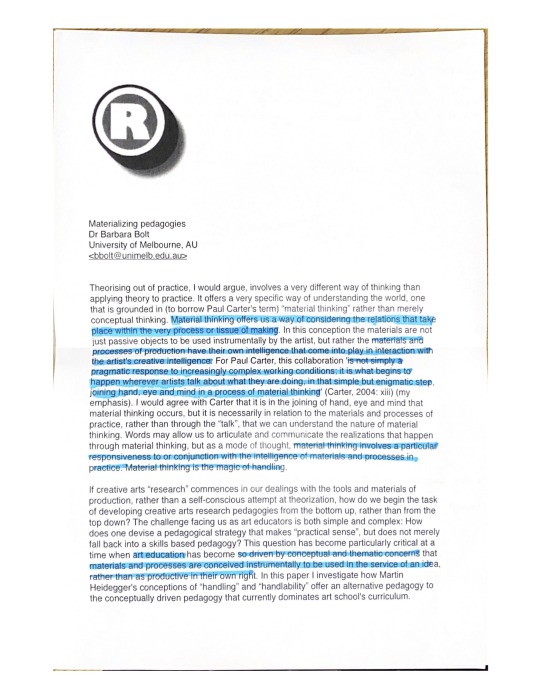
What Is Material Thinking?
Material thinking is a way of considering the relations that take place within the very process or tissue of making. Materials and processes of production have their own intelligence that come into play in interaction with the artists creative intelligence.
Choose One Of The Creatives From The Lecture & Describe Their Material Thinking?
Tatiana Tavares: Working artist and academic who studies the nexus of decolonial narrative and media language. Her creative doctoral thesis explores the possibilities of polyvocality and interactive digital narrative. Her research interests include practice-led research approaches, artistic and literary Latin American syncretism, magical realism, and emerging technologies. Her design work encompasses graphic design, creative writing, illustration, prop making, cinema, sound design, augmented reality, and animation.
How Can Material Thinking Be Seen Through Your Own Work:
Material thinking can be seen through my work through the use of typography, negative space and minimalism. I want to learn more through a deeper dive in research, reading articles, looking at other artists work and putting it into more practise.
How Would You Reference The Reading From Today?
Bolt, B. (2006). Materializing Pedagogies. Retrieved 15 August 2023 from https://www.herts.ac.uk/__data/assets/pdf_file/0015/12381/WPIAAD_vol4_bolt.pdf
Next Steps: Work on formative and start creating presentation in InDesign
The Creation: Themes That Influence Your Work
I looked into more examples of 'the creation' and what influences me as a designer and my work. I was able to find some very good websites and pieces of work that represents what I am interested in. I love how each artist has taken a different approach to all the types of work which sets them apart. Something I want to take on board is creating a style that best suits me, not only for comfort but also a theme that brings me out of my comfort zone and challenges me.
Typography
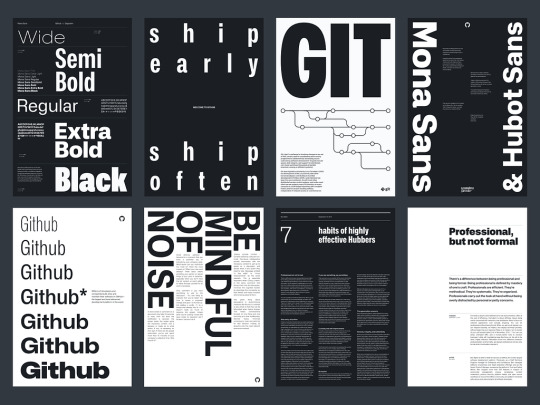
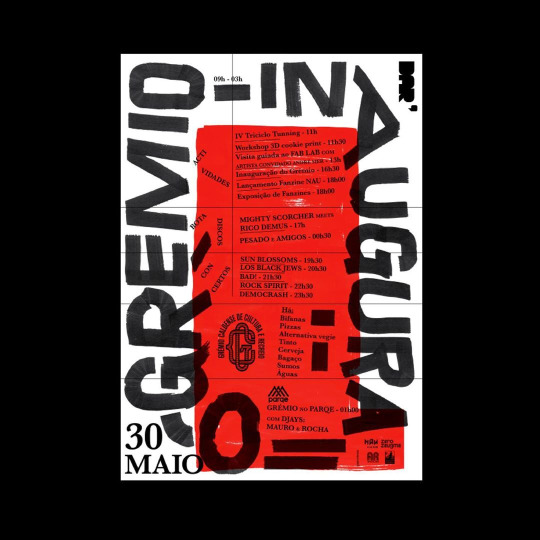
Barr

Studio Lindhorst-Emme
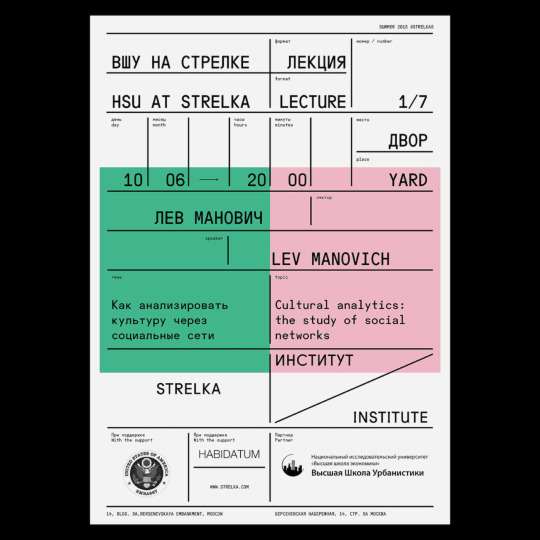
Lamm & Kirch
Minimalism / Negative Space
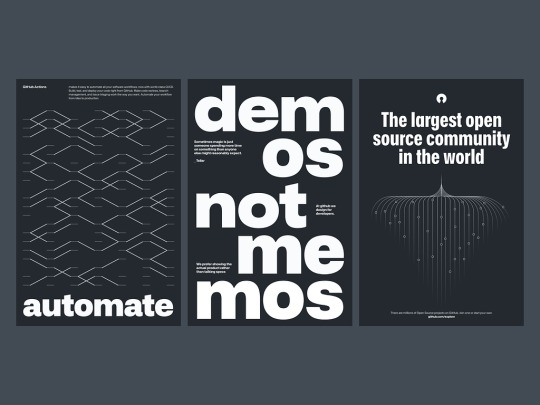

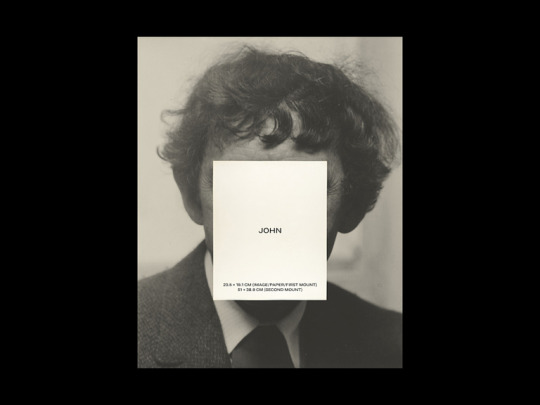

Collage

Kurt Schwitters
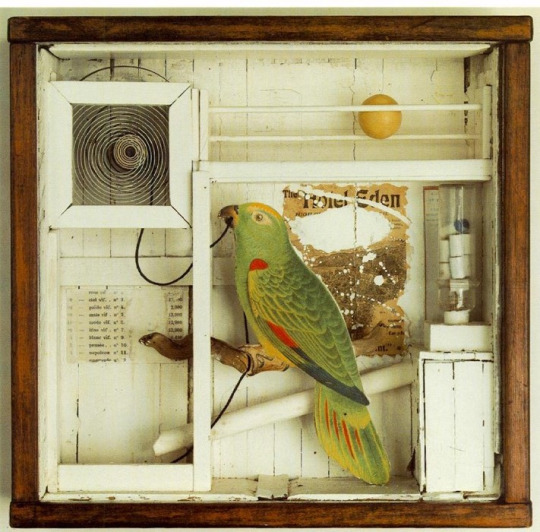
Joseph Cornell
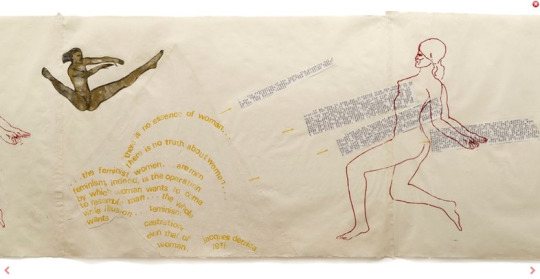
Nancy Spero

Annegret Soltau
AnOther. (2014, January 14). Top 10 collage artists: Hannah höch to man ray. AnOther. https://www.anothermag.com/art-photography/3318/top-10-collage-artists-hannah-hoch-to-man-ray
Illustration
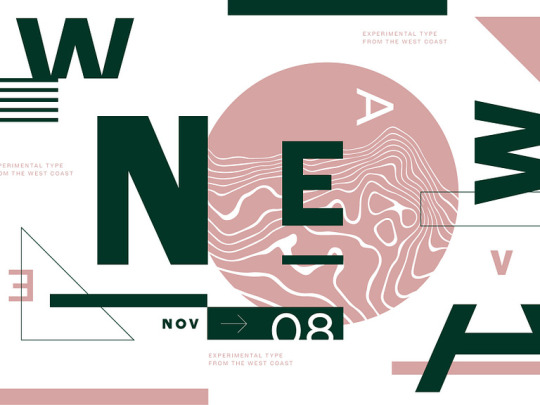


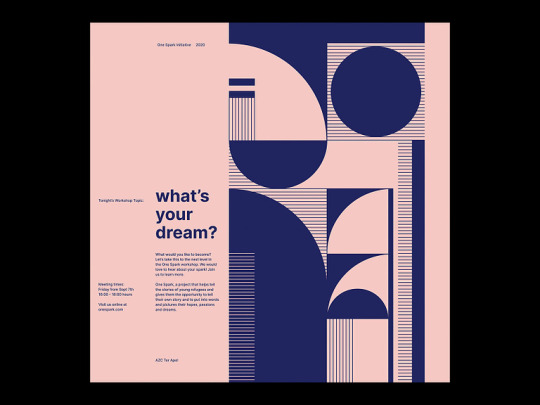
1 note
·
View note
Text
ARTIST RESEARCH BASED ON INTIAL IDEAS/INSPIRATION
youtube
Free Radicals (1958) by Len Lye
My inspiration to scratch into 16 mm comes from this piece by Len Lye. The piece includes 16 mm scratches and a sound scape of traditional African music from the Birgimi tribe. We get a unique sense of movement through the scratches and how it is moving in relation to the music. Lye worked with movement in his art practice as a celebration of energy which is described with the title “Free Radicals”. The style of the scratches relates to tribal art and connects therefore with the use of music.
youtube
The Unfinished Conversation (2012) by John Akomfrah
John Akomfrah is an important artist to mention in relation to the matters I am talking about. Worth to mention he was part of the Black Audio Film Collective and his film “Handsworth Songs” was quite signifcant to his career. The Unfinished Conversation is a three screen video installation and it portrays Stuart Hall’s life and work. Extracted images from news footage of the 1960s, alongside Hall’s personal home videos and photographs, are presented to merge the past, present and future.
I was inspired by the use of three screens that shows different aspects and then obviously the impact the work of Hall has had on my own personal experience.
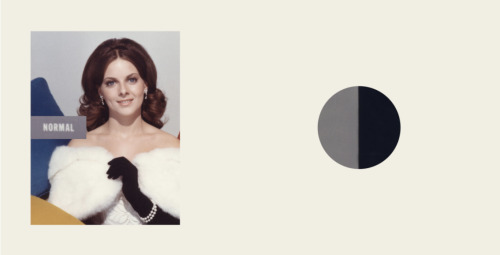
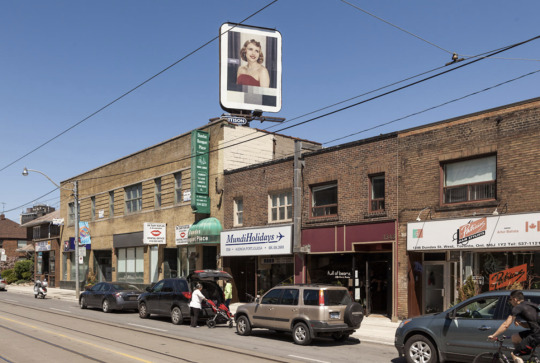
To Photograph the Details of a Dark Horse in Low Light (2013) by Adam BroomBerg and Oliver Chanarin
“The new images hijack the representational space of urban advertising to raise questions about the relationship between the social and the technical, and the possibility that politics is bound up with our material history.”
In 1975, French director Jean-Luc Godard called out Kodak film to be racist because he claimed that it was only made for white skin and he refused to use their film on an assignment in Mozambique. This gave the idea for Broomberg and Chanarin’s billboard campaign to use the Kodak Shirley cards as a reference for how white skin was labelled as “normal” and used as a point of reference to calibrate skin tone in a photograph. When Kodak did respond to these claims, the “Gold Max” film was made with the title “to photograph the details of a dark horse in low light.”
https://www.youtube.com/watch?v=d16LNHIEJzs


“Empire needs imagination to see the violent film. Empire needs Islands of imagination to see the light Empire needs violence to light its fire. Empire needs to see its islands, its isolation”
White Gaze by Michelle Dizon and Viet Le White Gaze is a book there was made in response to the National Graphic magazine. A magazine published in North America and Europe and known to document life and people. The two artists wanted to explore the history of photography with roots of the colonial power-relations and the creation of stereotypes. By looking at the original image and text, they were able to reframe and uncover an alternative history of each image. I was inspired by the how they have deconstructed the words that was originally used but into a meaning that make sense of today and how we look at colonialism. Article: https://www.lensculture.com/articles/michelle-dizon-vi-t-le-white-gaze
1 note
·
View note
Text
Top Gun, Propaganda, and Art
Can propaganda be good art?
As of the time of writing, Top Gun: Maverick recently rose to the 6th highest grossing movie of all time, knocking out Avengers: Infinity War. It has been praised for its cinematography, writing, direction, and performances. Tom Cruise once again takes to the skies, this time in an F-16 fighter jet with his (dead) friend’s son to gun down faceless enemies while quipping and laughing the whole way through. When I went to see it on opening night, every joke, every emotional beat, every story beat resonated with the audience. They were cheering when Rooster came back for Maverick, they were cheering when they hit the target, the list goes on and one.
Top Gun: Maverick is a crowd-pleaser. And it’s also the most expensive piece of US Air Force propaganda ever created.
From the Washington Post’s article about How the US Military made ‘Top Gun’, quote “Top Gun: Maverick received support from the Department of Defense (DOD) in the form of equipment — including jets and aircraft carriers — personnel and technical expertise.” And, in the original film “In exchange for DOD backing, the producers agreed to let the department make changes to the script. Maverick’s buddy, Goose, no longer perished in a midair collision because, according to the Navy, “too many pilots were crashing.” Meanwhile, Maverick’s love interest, Charlie, went being a service member to a civilian because Navy regulations forbid officers and enlisted personnel from having relationships.”
The US military directly funded both Top Gun and its sequel. They knew these movies would become hits, and took advantage of that fact to advertise the USAF to the people who watched it. Heroic pilots fight faceless enemies and always win, only the non-important side characters die. When a character actually dies, it isn’t from lack of training. The movie is made as palatable as possible to the average consumer, and at the same time, as much as an advertisement as a movie.
Oh, and that isn’t even getting to Lockheed Martin funding the movie and actively promoting it. At the start of the movie, Maverick flies an experimental jet, the SR-72 Darkstar, which does not actually exist in real life. Around the middle of the movie, Maverick describes their mission as a “cakewalk for the F-35″, comparing the newer plane to the F-18s they fly in. However, the F-35 was a trillion-dollar disaster. Overbudget and underperforming, one might question why F-35s are describes in a positive connotation if they’re not that good in reality. Well, that’s because Lockheed Martin, who built the F-35s, also, by total coincidence, funded and provided guidance for this film, and even promoted the film and the SR-72 on their website.
But...
Top Gun: Maverick is the most enthralling films of the year. Some of the best action sequences I’ve ever seen on screen, combined with career-topping performances from both Tom Cruise and (sorry Whiplash), Miles Teller. Once again, Tom Cruise proves his insanity and dedication by flying in real jets and doing his own stunts, along with the rest of the crew. It has topped the action movie lists of 2022 by a wide margin, and is honestly a great, well-rounded movie, if not a little lacking in the story department.
But, once again, Top Gun: Maverick is literal propaganda. So, what is it? Is this movie a wildly expensive, but effective propaganda piece? Or is an adrenaline-filled summer blockbuster for the whole family? Can we separate the message of the art, from the art itself? Is the message of the movie inherent to your enjoyment of said movie? In many ways, Top Gun: Maverick will be remembered. In a few years, maybe it will be the mainstream opinion that it was clearly propaganda, or maybe it will be that despite its underlying message, the movie was still good.
When the meaning, or the message of the art that is being presented to millions of people and raking in billions of dollars at the box office, is it moral to ignore the message of the art for the paint, to miss the forest for the trees? Top Gun: Maverick induces a confusing dilemma. On one hand, it is an incredibly fun movie. On the other, it ignores reality, and paints it heroes and villains into tiny boxes of black and white. Villains are hidden behind dark, black masks, to the point where you can’t make out the creases on their faces, or even what they’re saying. Heroes have their visors lifted up, so you can see the face of the good guys. In the end, our reality is mixed too. 5 star reviews accompanied by a cacophony of people pointing out its flaws, and how propagandist in nature it is.
But, we need to remember that the paint of the art only exists within the confines of the artwork. It is not splattered out onto the showroom floor. Similarly, Top Gun: Maverick’s heroic characters do not exist in the real world. They only exist on our screens, through ones and zeroes. To say that Top Gun: Maverick is a good film would be to also say that its message is a good one, because, in the end, you cannot separate the black from the white, the good from the bad.
The reality of the USAF is the thousands of dead Iraqi and Afghani children. The starving teenagers in the streets of Kabul who live from meal to meal. The children of Vietnamese adults who lived through the Vietnam War who bear the marks of a war they never lived through or asked for.
Because Top Gun: Maverick is a propaganda film. And no amount of fun action scenes or flashy volleyball games will ever change what it is.
Final Rating: 35/100
9 notes
·
View notes
Text
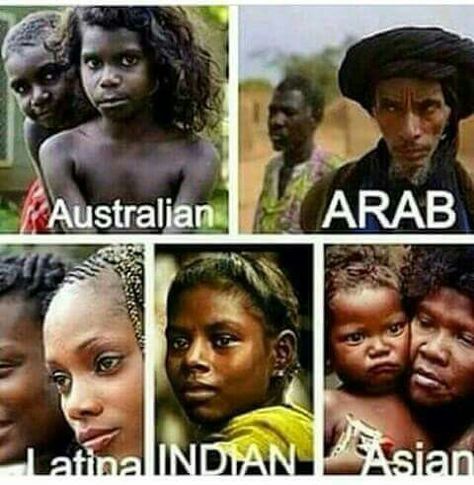
THE TRUTH AND SHAKA ZULU WILL KILL YOU
In a once-popular commercial for Calgon detergent in the 1970s, a curious housewife probes the Chinese owner of the local laundry for the answer to one of the world’s eternal mysteries: “How do you get shirts so clean, Mr. Lee?” After peering over his shoulder (so as to be sure that his not-so-discreet wife isn’t standing near) the man turns back around, raises a finger to his lips and says through a smile, “Ancient Chinese secret!”
While the answer to the question posed to the laundry owner by the woman was a closely guarded secret — one that his sweet, no-nonsense wife happily ruined — it was neither ancient nor even Chinese in origin. But the TV spot famously tapped into one of the most enduring legends about the country whose Ming Dynasty rulers had a 16-to-26 foot wall built around it: the age-old traditions of secrecy.
And, like Vegas, what happened in China very often stayed in China, just get the hell out of Alkebulan!!! But if you insist on staying, you and your barbarian invader horde of Ghengis Khan, wannabe warlords can take that beatdown like Hirihito of Japan. You can indulge in Alkebulan's rich resources for a season or get on a junk boat and go back to China and rebuild your own country. If you stay in the Motherland you'll perish🖕🏿🖕🏿🖕🏿🖕🏿. As the saying goes, s**t happens. Wash ya ass. Please, continue reading… my screwed up mind !!!
Take the Black Chinese [Moabites] who once made up the entire population of China prior to Esau's attempt at reclaiming the birthright God decreed would be Jacob's while in the womb through forced miscegenation "Raping of indigenous women." Do not be confused or mislead by this post. My research was sketchy to say the least. The portion of the population before China’s modern era does not register any indigenous Moabites, for example. The fact that you’ve never heard of them proves the point. Here comes the BS. But don’t worry. You’re not alone. China has some 1.3 billion people and nearly all are just as in the dark about them. Well, either that or a billion people all swore to never-ever-never air any [ahem] ‘clean laundry’ about black folks formerly having a place in China’s allegedly homogeneous society. That's a bunch of made up monkey s**t. Frankly, even an ancient culture with the bragging rights to the longest continually recorded history, another myth, is bound to miss a few things like a heart, and some effing genomes. The former presence — up until sometime in the 20th century — of Black people in pre-modern China is one of them. Fortunately, though, old photos taken throughout China around the advent of photography can help us to fill in today some of what the historians missed on purpose. I can't believe I'm posting this. 👎🏿👎🏿👎🏿👎🏿 China’s Qing Dynasty, established by the Manchu people who ruled from 1644–1912, is described as having been a vast multicultural empire. But it appears multicultural could also be a more pleasant euphemism for multiracial. You people are like dogs, stop eating them?! Nothing illustrates this better than the Black and white photos taken by visitors from Europe in the mid-to-late 1800s. Really?!! John Thomson, an Irish photographer was one of the first to capture images that reveal a surprisingly more diverse makeup of then-contemporary China. In one of the most stunning photos taken by Thomson displayed above, six women dine together in a courtyard. Captioned “Manchu ladies at a meal,” the picture was taken in 1869 in the city of Peking (now Beijing). Seated at the center of the photo are two women: on the right sits a typical high class Manchu and on the left sits a smiling Black woman — who could easily pass as the mother of the RZA, the GZA, Ol’ Dirty Bastard, or any other member of the Wu-Tang Clan.
Apart from the physical differences in the women (including the two who were likely seated, but stood for the picture), what’s also remarkable is that when Thomson writes about them, he makes no distinctions — though there were both racial and class differences; some of them were most assuredly attendants or maids. But in the view of Thomson, they were all simply Manchu ladies sharing a meal on a day when he sought interesting subjects to photograph. I saw the photographs. The darker ones were inherently claimed to be lower case workers or servants, while the ones who looked like Lucy Liu were considered affluent, and well off. These racial disparities that evolved from hell are a sad reminder to a wound that won't stop bleeding because of man's inability to stop giving in to his base emotions. I plead cray cray, and insanity. Jacob, they would rather burn in hell for an eternity than let us live in peace for a day. God is coming back for Israel not the Christian Church that has been corrupted by the Evangelical, right wing, nut jobs.
1 Maccabees 3:48
And laid open the book of the law, wherein the heathen had sought to paint the likeness of their images.
If you study history, and read the Bible, you'll see how religion has been used to divide God's people which they're not. Some gentiles will walk into New Jerusalem, the vast majority of them won't. The Bible has been tampered with by people who are shepherds for the Devil. The Catholic Church is Satanic no matter how you cut it. The cathedral of Notre Dame had gargoyles mounted atop the edifice looking over the city of Paris, France. Do you find this to be a bit of a double minded mentality or a slap of defiance in God's face. What god do you worship? We want to know the truth from God. This world can't be trusted with an anorexic T-Rex. You'd call it a crackhead and dump him in the Labrea tar pits unless it was a female, at that point you would attempt to crossbreed it with a Chihuahua, and hope to domesticate this new animal which has disaster written all over his I'm shaking cause I need a fix quick, petrified ass. When Vatican City is destroyed let that be a warning from God to those who still have a sliver of faith in God, get a relationship with Him. Jacob, this writing piece reveals their unwillingness, and froward hearted, lack of sensibility by not telling the whole truth. Instead they give us a revised version of history that wasn't. They have been our teachers for the last 500yrs when we were there's previous. Either you learn from your mistakes or continue to repeat them.
Zechariah 8:23
Thus saith the Lord of hosts; In those days it shall come to pass, that ten men shall take hold out of all languages of the nations, even shall take hold of the skirt of him that is a Jew, saying, We will go with you: for we have heard that God is with you.
If you hate being rebuked by a Black professor with a tenure ship, you'll hate being corrected by a Black child who has 5 degrees including a specialist in biochemical, ecological science, and psychology. You're ashamed because you're proud. There were great African kingdoms that educated the anglo European that's been shrouded in history. The book of Maccabees says the people who have mislead, and lied to us are as knowledgeable as a 13yr old using crib notes. I'm nuttier than a can of Planters, the truth is in you Jacob. Utilize the authority given to you. You will have to teach them as it was in the past. Everything from Bible scriptures, to aerospace, science engineering. The educational system is designed to hold back Black children, but the 3 people with the highest IQs in the world at the time was a 10yr old Black male, an 2 Black females under the age of 8. They were the youngest members of Mensa ever. This was about 4yrs ago. You can't stop God's anointing from glowing and glorifying Him and His people. Read the rest of this article and lose your mind. Its a nauseating and frustrating read. The truth will set you free. It ain't in these hood boogers
Written accounts by early Chinese historians tell us that the Tonkin region and its adjacent areas were once a hotbed of various non-Han Chinese peoples, including those from whom the Lao Cai girl descends. But with the southward advance of the Han Chinese, such groups were pushed even further south, or gradually assimilated into the dominant population. Historian Thant Myint-U writes in “Where China Meets India” that during the 9th century, the Chinese ethnographer Fan Cho compiled the Man Shu, or “Book of the Southern Barbarians.” Fan Cho describes there the varied peoples living in and around Yunnan. Included among them were the Wu-man or ‘Black southern barbarians,’ so-called for their dark complexions. And ironically, the French author of the Lao Cai photo had the image annotated with the Chinese word “Man,” and — sadly — with the Vietnamese “Xa” (or Kha), signifying servant or slave.
With this photo of a mother and her two children by John Thomson, taken on the streets of Peking (now Beijing), something finally clicked. For reasons that won’t be detailed here (as it would take far too long to explain) more than a decade of research into the peopling of Asia seemed to suggest that any black Chinese still living in the age of photography would likely all be found in southernmost China. Black Moabites still coexist in China to this day. This is a class study in you must be dumber than an incubator.
In his 1902 book The Boxer Uprising, American photographer James Ricalton includes this photo of several dozen men, many of them likely to be executed the next day for their part in the Boxer Rebellion. The latter was a bloody, anti-foreign and anti-Christian uprising that took place between 1899 and 1901; the 2006 Jet Li film Fearless was inspired by events that took place in the aftermath of the rebellion. The same is also true of the 1971 Bruce Lee film Fist of Fury. No actors in the aforementioned films — nor any other martial arts films set in pre-modern China — ever had actors resembling the non-Han Chinese mixed in above. About them, the racist Ricalton writes:
“This is truly a dusky and unattractive brood. One would scarcely expect to find natives of Borneo or the Fiji Islands more barbarous in appearance; and it is well known that a great proportion of the Boxer organization is of this sort; indeed, how dark-skinned, how ill-clad, how lacking in intelligence, how dull, morose, miserable and vicious they appear!” I'm willing to bet you 5 million in Bitcoin that I don't have, a lifetime supply of opium, and 2 happy ending massages daily that this bougie French bastard is rotting in hell praying to white Jesus that Rumiel won't screw him up the wahoo tonight. Tickle his sack!!! Like Thomas Cromwell the powers that be went to great lengths to cover this history in ChinaTown. You can't hide the truth from a people that's tired of being dictated to, oppressed, lied on, abused and persecuted by everybody, and discredited for the contributions they've made to this damnable planet. As previously stated we don't want crumbs [reparations] we want the whole planet Black before you, and the I hate n**gers brigade showed up, that includes Moo Goo Gai Pan. As soon as his Chicken fried, Bat Man eating, pancaked backside came along, and gained some freedoms, he started emulating his zaddy, he became drunk with xenophobia like the rest. If you hate my commentary tell ya boy Biden or his Amerikkka is not a racist country VP, Kamala Harris. She's next in line to preside as Pontius Pilate over this damnation unless Biden loses his dementia. Its a joke, think or buy a vowel. If that doesn't work, swap some Budha, and kiss Mr. Nasty bye bye.
6 notes
·
View notes
Photo

Translated interview
Exclusive interview with Noémie Merlant and Adèle Haenel, lead actresses in ‘Portrait of a Lady on Fire’
Dariusch Tabatabaei, Netzwelt.de, 31st of October 2019
Additions or clarifications for translating purposes are denoted as [T: …]; I have used the English title of the film rather than the German one (see first question)
[T: Omitted intro and recap of the film]
‘The love story that the film tells is the creation of a love story. Both of the main characters reinvent love for themselves, and also for the future.’ Adèle Haenel, who plays Héloïse in ‘Portrait of a Lady on Fire’
[…]

Interviewer: The translation of the film [T: title in German] ‘Portrait of a Young Woman on Fire’ is not entirely correct. In French, it is ‘Portrait de la jeune fille en feu’, in German it is: ‘Portrait of a Young Woman on Fire’, [T: the former] is a definite article[, the latter is] indefinite. Do you think it makes a difference? Also, with regards to how viewers are going to interpret the film? [T: IDK, this was the weirdest first interview question I have read so far… but Adèle gives the best answer!]
Adèle Haenel: Wow… why would that make a difference? I think, it would have to make one. I don’t know. I don’t think it changes a lot. I even think that ‘a Young Woman’ is more global. The film is about a very specific love story, but it’s also one among many. A woman among so many! Every woman wants to be alive in this society. ‘The Young Woman’ is just the one, it is more heroic. I think, I like the German translation, because then we are all heroes.
I: To stick with the young woman on fire, which of your characters, Marianne (Merlant) or Héloïse (Haenel), is the eponymous woman on fire?
AH: I would say it’s Héloïse, if you look at the film poster, no? Especially because I was really set on fire during the shooting. But it’s a bit blurrier than that.
Noémie Merlant: I think, it is a shared love, shared art. So, if she [Héloïse] burns, then the fire spreads, and I burn as well.
I: Could you describe how both of these characters burn? Do they burn in different ways?
AH: Fire is something poetic, it is very complex. You can interpret it in many ways. You can say: ‘Oh, it’s ending soon’, or ‘It will never stop burning!’ It’s meant to be more poetic.
NM: The women in the film burn, because they have these desires. It’s part of the film that we live our desires, burn for them. But there are also regressions…
AH: There is something absolutely contagious, how love is a mixture of desires, desires that are talked about in the film, and [T: it also includes] arousal, intellectual arousal. Love is an adventure! It’s about creation. And all of this leads to [T: the fire] spreading. But it’s not like it’s choosing: That is the part of my life, which should burn. No, no, it’s spreading everywhere. That’s why I think we shouldn’t specify it so much…
But to talk about our characters, I would say even though they are different, they meet each other and completely change. Both Marianne and Héloïse do a U-turn [T: 180-degree 🤷], from the beginning to the end of the film. And we also talk about the echo of love in the film. You’re not only changed by it, but you also change your relationship to love. The love story that the film tells is the creation of a love story. Both of the main characters reinvent love for themselves, and also for the future.
I think, the film is also a great way to reinvent what a love story is. What happens after the love story? What happens during the time [T: when the love story takes place]? We learn that the love story does not just end because of this or that reason. In our situation, it’s [T: because of] the political structure of society. Even when it’s over, what do you do with this memory of love? How do you carry it in your heart? Invent your own relationship with love!

I: Ms Haenel, you have already worked together with the director Céline Sciamma, as you also were a couple, you know each other well. Whereas you, Ms Merlant, didn’t know the director, or rather have not worked with her. What is the advantage or disadvantage of knowing the director or not?
AH: It’s difficult to talk about this in general, it’s always about specific relationships. It depends on who you work with. I think with Céline […], it’s an advantage to be on the same path. I know what Céline is searching for, and I know how to do the best possible, so that I can be on that same path with her. And the way how she searches for beauty really moves me. That’s why I think it’s an advantage if you know each other. But I also think that it’s quite important and interesting to meet new people, like Noémie. She brings her own perspective and own mystery to the film, which creates a magical chemistry.
NM: Yes, it’s hard to say whether this changes anything. Céline is someone who… you know, there are people that you know well, but they are quite distant, and then it doesn’t work, and there are other people that you don’t know, but it feels like you’ve known them all your life. These people open borders, their arms and then it’s just… easy. It’s easy in the way that these people connect with you, because they are sincere, friendly and accommodating. Céline is also very clear about her ideas, open for suggestions and gives you everything you need. It’s a relaxed collaboration.
I: Do you have a ritual or similar that you always do before shooting?
AH: It’s just work, there is no specific ritual. That’s why I can’t answer your question. I truly believe in films, and I believe that you have to give your best, that’s why I only do films that I believe in. And that’s why I take the work on set very seriously…
NM mutters something to her with a grin: Sure, there is one thing that you do!
AH: What do I do? (She smiles and points at Noémie Merlant.) She seems to know.
NM laughs: You know! What you always do, before every scene…
AH: Ahh, …
Noémie Merlant circles with her hand around her face and has to laugh.
AH: Oh, I do some exercises with my face.
NM: Yes, or listen to certain music before a scene. It’s always different and depends on many things. There is nothing that I always do. But there are a couple of technical things that we all do most of the time. For example: (She is doing some stretching.) But nothing specific. If there are too many things in your head, it’s tougher. You have to turn inward and shake everything off, shake your body, your mouth, your eyes, your fingers, breath! …
AH: It’s like a sport.
NM: Yes, it’s about being in the here and now! Meditating, stretching, breathing exercises!
I: Thank you, before we conclude the interview, I would like to know if there’s any question that you always wanted to answer in an interview, but didn’t have the chance yet, because no one was asking it?
AH: Nope, we just wait for the questions and answer them. We don’t need anyone to ask us specific questions.
NM: Besides, you can somehow sneak in some answers, no matter what you’re asked. (She underlines this with a wavy [T: snake-like] movement.)
[T: The original interview was conducted in French/English and then translated to German… and now translated back to English. Circle of life 😁]
#Netzwelt.de#2019#German interview#Adèle Haenel#Noémie Merlant#Portrait of a Lady on Fire#The questions were ... inspired#Anyhow their answers were fun#My translation#long post
179 notes
·
View notes
Text
Angels and Art History
932 words, rated T (read on ao3) Castiel Googles “3 month anniversary” and has a question. Why do people use “angel” as a romantic compliment? Part of my anniversary series!
Sunlight on his face wakes Dean from a wonderful night’s rest. He opens his eyes slowly, still trying to preserve the memories of his dream. It was a good one, of that he’s sure, but the details are gone by the time he opens his eyes all the way. He turns his head, expecting Cas to be next to him in bed. He’s not. Dean puts his hand out to pat the empty space. Probably making coffee, Dean thinks as he sits up and stretches. It’s confirmed when he hears the coffee maker beeping through the slightly open door. Dean runs a hand through his hair. It’s gotten longer lately, definitely shaggier than he’s ever let it get before. But Cas likes it. Gives him something to tug on.
“Dean?” Cas asks, interrupting Dean’s thoughts. He’s wearing one of Dean’s old band shirts, so worn he can barely make out the logo anymore, and gray sweatpants. Dean thinks he looks best like this - comfortable. He pushes the door to their bedroom open with his shoulder, laptop in one hand and powder blue coffee mug in the other. Dean makes a mental note to buy Cas another fuzzy bee decal - the one already on the laptop is starting to peel off. Dean turns to give Cas space to sit down.
Cas hands him the coffee, and Dean falls just a little more in love. He takes a sip as Cas kisses the top of his head. Cas sits down next to him, criss-crossing his legs to settle the laptop on his thighs.
“What’s up?” Dean asks, leaning into him.
Cas points at the screen. Dean sees he had Googled “3 month anniversary” which, first off - cute, and second off - yeah. It’s the fourteenth of the month again. Wow, time goes by fast.
“Why do people use ‘angel’ as a romantic compliment?” Cas asks.
Dean takes another sip and looks closer. Cas seems to be fixated on an article from some dumb lifestyle website which states, “In fact, ‘three months is an important milestone in most relationships,’ Keegan says, ‘because that's the point where a lot of people begin to see the cracks in the other person.’ In most cases, up until ‘that point, they were just an angel on earth and they were living in a bubble of love.’”
Now, Dean doesn’t know who this “Keegan” person thinks they are, but that sounds like bullshit. Like he’d ever see “cracks” in Cas, let alone after just three months. Well, maybe Cas had started to see cracks in him. That seems possible.
But when Dean looks at Cas, the thought is banished from his mind. Cas looks back at him so fucking fondly. And the guy makes him coffee every time he wakes up first. Surely that’s love, right? He takes another sip and Cas just watches him, waiting for an answer. He clearly doesn’t think they’re about to have relationship problems - and screw Dean’s stupid brain for even entertaining that possibility. Cas just wants to know about the “angel on earth” thing.
“Well,” Dean starts, “you gotta think about the, um. Pop culture angels. Y’know, halos, fluffy wings, beings of goodness. Not the warriors of God types.”
“So more like cherubs?”
“Yeah.”
“I thought that might be the case. It made me think of the way people have depicted angels in art.” Cas closes the laptop, setting it down on the floor in front of him.
“Tell me about that,” Dean says. Cas smiles at him. Dean moves to sit up against the headboard, settling in to hear a mini-history lesson. He loved listening to Cas talk like this. Cas turns to him, still cross-legged. Dean puts his feet in Cas’ lap and Cas takes the right one, idly massaging it as he starts talking.
“You started adding wings very early on, to represent otherworldliness and flight. Angels were messengers, flying back and forth from Heaven and Earth, and since you didn’t know how we did that...wings. Although, they hardly look anything like the bird wings artists used as reference. The Bible doesn’t describe us much, and how could it? We were beyond human comprehension, really.” He switches to Dean’s left foot. “The Renaissance saw the start of angels as beautiful. The iconography quickly became ‘beautiful winged human in robes’ and didn’t change much for a long time. So I can see how being called an ‘angel’ could be a compliment, if you wish to conjure up the image of purity and beauty.”
“I think you’re beautiful.”
“So you’d call me an ‘angel on earth’?”
“That’s what you are, no?”
Cas chuckles. “Yes.”
“Plus,” Dean continues, setting the empty mug down on the side table, “I bet your ‘beyond comprehension’ form is hot, too.” He withdraws his feet and puts his hands on either side of Cas’ legs, leaning into him. “You should show it to me sometime.”
Cas kisses him, just once. “I’d love to, but I like your eyes the way they are: gorgeous, green, and not burned out.”
Dean pouts and Cas giggles at him. “Fine. But only ‘cause you called ‘em gorgeous.”
Dean kisses him again, open-mouthed and lazy. He can taste the coffee on Cas’ tongue. Cas hand goes up to the back of his neck, and he pulls on the hair there. Dean moans into the kiss, the thoughts he was having before Cas walked into the room reigniting.
“You think Renaissance angels liked doing this?” he breathes against Cas’ mouth.
“I don’t know, but warriors of God definitely do,” Cas answers, tugging harder this time.
#my fanfic#mine#Destiel#Destiel fanfiction#happy anniversary dean and cas#this was short and fun lol it took me like an hour#supernatural
16 notes
·
View notes
Text
Castor - character bio
I’ve been struggling with getting a bio out for Cas for waaaaay too long now, but i feel pretty ok with how it looks currently - i'm going to repost it on my art blog with some drawings of Cas and Hjalle in the future (hopefully). If you want to skip most of the nonsense and just get a feel for her personality, the section under the bio paragraphs is FULL OF POINTS.
links to drawn refs here and here
Longpost under the cut

✦ Early life in Hjalle:
Being born into the noble family Aran, Castor’s early life consisted mostly of being pampered by the attendants and strict education. Cas was a rowdy kid, and with time, lack of affection and validation from her family served to amplify the trait - she went from occasionally disobedient to full-on antagonistic towards her parents, and the nobility as a whole. She began to sneak out; spending her time outside of the Fort, spying on the guards and trying to bribe knights into taking her on as a page.
When Cas turned nine a sibling came into the picture, and she made it her duty to assure Aster’s upbringing would be better than hers. She poured everything she had into Aster, but soon developed a brash and overbearing streak, unyielding in her focus to teach the meek little sister to stand her ground. Aster became torn between Cas and the parents, who in all fairness, treated her much better than their firstborn. This would remain the case until Castor’s dragon-induced injuries.
In her late teens, Cas was seldom seen in the fort - to everyone's great relief. Her mood was always sour, she gave up on her studies and only seemed to care about Aster and joining the hunting parties. Her parents reached their limit when Castor announced she would not become one of the renowned judges of House Aran - this led to an explosive argument, which concluded with Castor storming out. For the following two years, she lived and worked with rangers tasked with protecting and providing for the town.
It was in those years that Cas acquired her battle prowess and scars, the most prominent being a gift from an especially large and angry dragon. A single swipe of its tail tore Castor’s chest and forearm open, forcing the hunting party to rush her to the fort in (what the hunters expected to be) a futile attempt to get her family to provide medical help for their dying kin. The reception was cold indeed, and if it weren’t for Aster’s hysterics and outrage over her family’s indifference, Cas would have not survived the grievous wounds. The upside to this event was a new high tale to impress people with, and strengthening the bond between two sisters. The downside - Castor was now under her parent’s thumb. They made her accept the position of inquisitor; to make up for the hassle she caused them. Taking up the mantle turned Castor’s world upside down - not only would she have to work in close proximity to her father, but her dreams of being knighted were shattered, as inquisitorial duties stand in stark opposition to virtues of knighthood. As Inquisitor she was tasked with investigating and interrogating for the court - the latter, as Aran tradition had it, was extraordinarily bloody.
✦ Vesuvia:
Almost as soon as she arrived, the city sparked something in Cas. This was unexpected to say the least; she was certain the years of gruesome work as inquisitor numbed her to simple joys of life. The sights and sounds of Vesuvia however, made her eager to explore and see how everything ticked - and the more she saw the more she wished to remain in the city. After attending the Masquerade and becoming acquainted with Asra, Cas was prepared to do anything to stay - even if it meant sucking up to the Buffoon count and begging for a job. Lucio proved to be anything but opposed - he’d heard of the “bloody good shows” (pun intended) Castor was infamous for, and was eager to take her off her parents hands. This led to working parallel to the count and his court, but also enabled Cas to dabble in magic under Asra’s tutelage.
This slight betterment of Cas’ situation would not last long however, as The Red Plague took complete hold of the city mere months after she took up her residence in Vesuvia. After perishing, and being brought back by Asra, she very slowly regains certain memories and traits - her sister, love of astronomy, sword skills. She sneaks out, snoops, and is a handful overall; but Asra is happy to see Castor’s “new” self free of bitterness and pain.
After this point, the “game events” take place. I like to imagine Castor braving an amalgam of Nadia and Portia routes, with a fistful (or multiple) of courtier drama. Castor is tasked with an investigation, slowly but surely unravelling how deep the corruption runs in Vesuvia, and how much of it can be attributed to the courtiers. The conclusion of her story focuses on first facing off against the court, then the Justice Arcana.

✦ Physical appearance
Light olive skin, she picks up a slight tan in Vesuvia.
Dark gray eyes, striking marbling on the iris.
Long girl - 176 cm tall, loves being the “tall friend” (and manhandling people close to her). Being taller than her is taken as an indirect challenge.
She has a rectangular body type, could be described as a “runner’s body”.
Prominent scarring across right forearm and torso, missing right breast.
Tastefully disheveled. Her hair has a constantly windswept quality, and the gray streaks seem to be especially unruly.
Inherited the “Aran silver” (early graying), she tries to ignore it. “The more you hide it, the more it shows”.
Secretly really bothered by the many similarities to her father. Avoids looking at herself too much, and whenever she does it feels like he’s looking back at her, judging.
Only ever smoothes herself over before important court meetings and social events. She doesn't know how makeup works, so before any party she asks Asra to sort her out. Cas looking prim is both a treat and a source of friendly jabs.
✦ Character traits
Power walking by default. This can be somewhat intimidating, and she won’t stop if someone is in her way - just put them to the side and continue.
Puts up a really convincing pretence of formality and refinement.
In actuality she finds this facade tiresome, and just wants to talk fast about battle/hunting feats or astronomy. Maybe show off her pyromancy.
Loves socializing, it recharges her batteries.
Dilligent worker.
Tends to overwork herself and neglect her relationships.
Often scatter minded and wanting to do too many things at one time.
Doesn’t appreciate people instigating physical contact or getting up in her face. She needs to prepare herself for it, or be the initiator.
Stubborn as a mule. Never knows when to stop pressing people.
Extremely callous at times.
Annoyingly overbearing
Most of this springs from a place of fear - things had a habit of getting worse whenever her family imposed decisions onto her. In her mind, if she’s the one holding the reins, everything will be better. And if something does fail - she will be the only one to blame.
Starting arguments comes much too easily to her, but she’s just as quick to introspect, and seek out the person she argued with to apologize and approach the issue in an appropriate manner.
Forgives easily
Eternally scoffing at astrology. She knows shes being bigoted, but at this point its almost like an inside joke between her and Asra. “Astrology? It's baby stuff. PSEUDOSCIENCE!” (she cries as she worries over her afternoon tarot reading and preparing pretty horoscopes for the Shop...)
A huge hypocrite at times. “Do as I say, not as I do” could easily be her motto.
Both the upright and reversed Knight of Swords card sums her character up perfectly.
✦ Occupation & Residency
Vesuvia:
Beginning of her story follows the game canon almost to a T - Cas lives with Asra in the Shop, and works there. It bores her to death, and she plays tricks on every customer just to entertain herself.
After being officially hired by Nadia as the Palace Magician, Castor moves out of the shop and purchases a modest house in Goldgrave, much below the value of what Nadia offered her, and what she could afford. It’s convenient and that’s what matters to Cas. She continues supplying the shop diligently, and takes over whenever Asra runs off.
Nadia insisted on Castor having an office in the palace. It grew on her with time, and after The Devil is dealt with it becomes her little “hub”.
Hjalle:
Cas lived with her family in the castle site until 17 years old.
After denying her parents their plans for her future as a judge, she hunkered down in a hunting lodge outside of the town, and spent almost two years living that way - she still thinks of these two years as the most joyous time in her life.
The only thing she ever used her family’s wealth for was commissioning the construction of an extravagant observatory. Reminiscent of a gothic fortress, the stark exterior is contrasted with insides filled with artwork and art-nouveau ornaments. The central chamber is a vast library with a powerful telescope in its apse - it is a sight that could take the breath of the most haughty of nobles.
There’s a tiny living space below the main chamber, furnished sparingly, but with a lovely fireplace (in Hjalle, its a necessity). It’s where Cas stays after becoming the inquisitor/whenever she visits after the in-game events.
✦ Trivia
Cas is 23 years old when she first arrives to Vesuvia - 28 at the time of The Devil’s downfall.
She freed Merlin from a merchant’s cage in the Red Market, during one of her outings in the three year interlude after her death - Asra fumes after they find out she snuck out to the market - yet is amazed that Cas found a familiar.
Cas regained her first memories via touching objects linked to her past life - a letter from Aster, articles of clothing, a sword...
This self re-discovering takes a turn for the worse when Cas finally finds a large, ornate knife - the one she inherited after becoming inquisitor. The memories it resurfaces are a staggering blow to Castor, completely derailing the beliefs she had about her own person. She thought of herself as a paragon, and remembering the torture she inflicted upon others, the lives taken in the name of “justice” made her relapse into bitterness and disenchantment. She deals with those feelings as her investigation into the courtiers progresses.
Predominantly uses pyromancy, other types of magic are strictly used for her work at the palace, and rather sparingly.
Could be best described as a battlemage - enjoys being in melee range and assaulting her quarry with both sword and fire; the latter being used more as a way to distract or stagger the enemy than actually harm. There's no fun in just burning them up!
Doesn’t cook for herself, although she has a natural knack for it - will only cook for guests and short people.
Her dislike of Lucio clashes with gratitude for employing her when she first arrived to Vesuvia - he was the knife which cut Cas off from her parents, and it’s something she could never forget.
Demiromatic/sexual.
She was offered to be knighted by Nadia after defeating The Devil. Cas declined - It’s much more than a title to her, and accepting seemed like mockery (considering her past as inquisitor).
Short fuse, she learns to better control herself while working in the palace. But if someone really pushes her the nearby candles miiiight get a bit out of control. Or she’ll just throttle them.
Hates her full name - Castor is such a mouthful. Sounds stuck up too...
#mc cas#castor aran#apprentice castor#oc bio#longpost#im pretty sure this is just incomprehensible#also text formatting on tumblr SUCKS i never knew until now#ive beed rewriting this for SO LONG NOW and im TIRED#so ill just leave it here#and if i ever feel like i can do better#oblivion is but a click away#begone#post#i cant write so PLEASE forgive me for the sins contained in this
25 notes
·
View notes
Text
My Journey as an Interpreter
When this course began, I was in the dark about the whole concept of nature interpretation. Unsurprisingly, I assumed it would mainly entail developing increased awareness and mindfulness when spending time outdoors. I figured this course would help me learn to share those experiences with audiences from all kinds of unique backgrounds. My role as an interpreter before ENVS*3000 focused on topics surrounding my studies as a science student. Being in university has a way of making school the primary lens through which you perceive the world; at least, that has been my experience. As a result, when I look at the world around me, it is easy to recognize the ecosystems at play and the unique interactions happening within them that are essential no matter how small. As a science student in my final year of study, the natural world's complexity is evident, and for me, this is one of the most humbling thoughts to entertain. It is crucial as an interpreter to be mindful of the natural world's sheer magnitude, something often overlooked by the anthropocentric society we are immersed in.
In nearly any situation, humanity has a way of commanding attention, but learning how the complex systems at work in nature genuinely are, makes it clear that it really is a delicate balance. It can also be an eye-opener for many to realize humans are not as pivotal to Earth's well-being and function as we are conditioned to believe. Humans have less control over the world than we would like to admit. Although the environment is plagued by the seemingly infinite number of challenges resulting from human activity, the wilderness will and always should stay out of our control. As interpreters, it should be our role to help others recognize the power and knowledge found within nature and the positivity it can bring to our lives when we do our part to care for it and maintain its integrity. When we care for the Earth, it cares for us by healing our psyche and fostering our physical well-being.

Photo by Lukasz Szmigiel on Unsplash
My development as a nature interpreter is heavily influenced by my personal morals and the belief that good interpreters should share the knowledge and power nature offers. The things most important to me that define my personal ethics as an individual and as an interpreter are respect, integrity, and the value knowledge holds. As interpreters, our primary role is to share the knowledge we have with others so that they may achieve the same benefits we do as a result of forming a meaningful connection with nature. Additionally, I think it is our job to teach others how we know to be respectful of the environment in sustainable ways to maintain the integrity of our natural surroundings. When discussing my development as an interpreter, my mind automatically jumps to my future role as a science teacher. I am starting my Bachelor of Education this upcoming fall to teach high school science, a clear showcase of my priority to share the invaluable knowledge that exists in the field of science with others.
I have always loved sharing what I have learned with people around me, even if it's just a remarkable fact I learned in class that week with a friend or even my mom. The key here is how significant knowledge and learning is to me, and I think this goes hand in hand with honesty, integrity, and respect, morals by which I try to live my life. While these factors are those by which I guide the actions and decisions I make in my life, they are also the ones I focus on when interacting with the natural world around me. Being respectful is one of the most important things to keep in mind when getting out and experiencing nature, especially to maintain the integrity of the ecosystems and the organisms that rely on them. Connecting back to my future as an interpreter through the role of science teacher, I can share these ethics with the students who enter my classroom and show them the importance of the environment and how they can personally maintain nature's integrity.

Photo by Kelly Sikkema on Unsplash
Continuing my role as an interpreter through teaching science introduces a variety of responsibilities. First and foremost, teaching youth to respect the environment and do what they can to improve nature's conditions whenever possible. Environmental stewardship offers benefits to the domain directly, but it also provides an outlet for individuals to connect and spend time outdoors. I believe nature holds so much power, be it in terms of psychological relief from stress or anxiety or a physical escape from the hustle-bustle we are affronted by in modern society. I believe it is a gift to be shared, and that is our responsibility as teachers and as interpreters of the natural world. As mentioned in Rodenburg's article (2019), today's youth simply are not getting outside to experience nature the way many of us did as kids, even though that really was not so long ago. In a world that has been rapidly developing new technologies for even more convenience, people are beginning to forget to slow down and appreciate what is around them, and children are not exempt from this. It is so important to foster the connection between humanity and the environment to avoid "nature deficit disorder," a term coined by Richard Louv in the textbook (Beck et al. 2019) to describe the detachment between humanity and nature.
Throughout history, nature and humanity have always been intertwined; one can never exist without the other, so nature deficit disorder can introduce various challenges. Perpetuated by modern society, nature deficit disorder can manifest in countless ways that exemplify the physical, social, and cognitive deficits that result from the disconnect with nature (Beck et al., 2019). Teachers have so much power to initiate reform by educating and inspiring their students who will grow up to be the policy-makers, business owners, scientists, teachers ultimately, the future caretakers of the world. The impact teachers can have on their students is undeniable, which is a primary aspect of effective interpreters, which is a significant reason I decided to pursue a career in teaching to make a difference.

Photo by Element5 Digital on Unsplash
Everyone will have a unique perception of the broad privileges granted by the environment that expresses the individuality between people. As an interpreter, it is vital to focus on the various things that catch different individuals' attention, providing insight into the unique personal relationship held with nature and their relationships with others and even within themselves. There is a valuable connection between humans and the environment from the deep evolutionary history that forever links the two. Creating a strong relationship with nature and helping others to do so will aid mental wellness by reducing stress, anxiety, and depression, elevating mood and reestablishing attention to the physical health benefits that include promoting cardiovascular health and reducing obesity by staying active. There are many benefits to support the power of getting involved in the environment and building a personal relationship with nature. I believe that to be one of the responsibilities of a nature interpreter and a science teacher.

Photo by Steve Halama on Unsplash
This course provided invaluable knowledge about how to reach a variety of audiences, but more importantly, it allowed me to gain insight into my personal relationship with nature. While learning techniques to improve the way I can share my own interpretations with others has been amazing to prepare me for my time in teachers' college. The enhanced relationship with the natural world has provided me with much needed benefits and escape from symptoms of nature deficit disorder and many other aspects of nature I had never recognized before this course. I always knew the importance of the environment when it comes to science, of course, and in art based on the numerous art pieces or musical creations inspired by nature. This course expanded my appreciation for the incredible impact nature has had on humanity throughout history, but it is even more important in society today.
Thanks for a great semester everyone!!
Sierra 🌼
References:
Rodenburg, J. (2019). Why Environmental Educators Shouldn’t Give Up Hope | CLEARING: A Nonprofit Magazine for Environmental Education in the Pacific Northwest. clearingmagazine.org. https://clearingmagazine.org/archives/14300
Beck, L., Cable, T. T., & Knudson, D. M. (2019). Interpreting cultural and natural heritage: For a better world. Urbana: Sagamore Publishing
9 notes
·
View notes
Text
My mother and I laughing, 2000

Eran and His Father, 2000
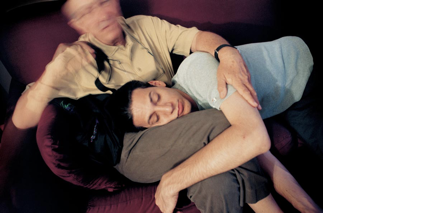
Love, 2009
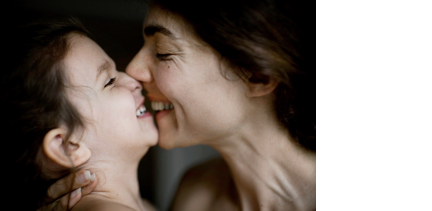
Father and Son,2010

Elinor Carucci: Closer and Mother Elinor Carucci is an Israeli American Fine Art Photographer. Her personal works usually about family, motherhood, and relationship. In her images, her parents, children, and spouse are the main character. Her works catch people’s eyes because the color of her photography is vivid with little grain and the atmosphere is more loving. The following is a discussion of two bodies of her work - Closer and Mother. Carucci’s Closer taken on her birthplace, Jerusalem during 1993 to 2003. The inspiration for this project came from her mother, so Carucci focused on showing her close family relationships. While the series describe depend relative, it also touches on the moments during her daily life such as kissing, touching, and hugging. In My Mother and I Laughing (2000), Carucci and her mother sit on the bed; she only wears a suit of underclothes, and her mother only has a loose white T-shirt. They wear very comfortable clothes in a private place. In addition, her mother looked at the camera, and then Carucci lowered his head and laughed. It seems like that they have a chat with the viewer. In. the title, Eran and His Father, (2000), Carussi’s husband, Eran, who falls asleep on his father’s ham and hug the lag. And then, Eran’s father places one hand on Eran’s body. Elinor Carucci’s Mother series starts with her pregnant (2004) and finish at her children are 8 years old (2012) in New York City. As with her previous series, Closer show the relationship between family, Mother series also shows an amount of intimacy with her daily life. However, this time she has a new identity, a mother. She uses the camera to record every emotion in her motherhood including she hugs, holds, and kisses. Her actions become stronger. In a TIME, article “The Most Intimate Dance: Elinor Carucci's Photos of Motherhood” by Susan Bright, the author states that “The little-discussed eroticism that so often exists between mother and child is played out honestly and easily – a beautiful, fluid link between generations”. In the Love, (2009), she and her daughter laugh and close to each other. They have the same smile face; her daughter looks like a girl who she used to be. In the same way, Father and Son, (2010) is also a sweet photo. Carucci’s husband falls asleep with their son; the father hugs his son with peace, and the son might just wake up. Superficially, to fix the issue, there are many similarities between Closer and Mother. First and foremost, all of them are portrait photography. Carucci aims to capture the personality and mood. Moreover, they are photography in a narrative style. Carucci records the daily life of her family. More than that, both of them have the same theme that intimacy in a family. In the Closer series, it describes the relationship between mother and daughter, father and son. It is the same as Mother series. The main subject in these four images is parents and children. They caught my eye immediately because the children, who in the Closer series become parents in the Mother series. It makes me marvel at time and change. When I look at these photos, I think of my future. What does it look like? In order to show their intimacy, their distance is so close as they are hugging and kissing. Both are placed indoors, so their atmosphere is more relaxed and peaceful. The biggest difference between Closer and Mother is that they are different light. As an interview by Mark Alice Durant, Carucci states that “I use available light in Jerusalem…Israel’s sun is stronger and there is a lot of light everywhere.” In the My mother and I laughing, (2000) and Eran and His Father, (2000) the light is sunlight, so the tone of this series photos is so warm. But, in the Mother series, Carucci does not use warm light. To compare these two series, the tone of Mother is cooler than Closer. Also, they have different methods of working in the images. In the Eran and His Father, (2000) Carucci uses motion blur photography; the arm of Eran’s father is blurry. This method makes the picture more like real life. Both of the My Mother and I Laughing, (2000) and Eran and His Father, (2000) close the distance between the project and viewers because the characters look at the camera, audiences will feel like “come into” the photo; the characters are talking to the viewers. However, the Love, (2009) and Father and Son, (2010) do not allow audiences “come in”; they might just think that this family is loving.
cited works Durant, Mark Alice. “Elinor Carucci.” Saint Lucy RSS, saint-lucy.com/conversations/elinor-carucci/. Bright, Susan. “The Most Intimate Dance: Elinor Carucci's Photos of Motherhood.” Time, Time, 30 Sept. 2013, time.com/3802764/the-most-intimate-dance-elinor-caruccis-photos-of-motherhood/. CARUCCI, ELINOR. “ELINOR CARUCCI.” Closer, www.elinorcarucci.com/closer.php#0. CARUCCI, ELINOR. “ELINOR CARUCCI.” Mother, www.elinorcarucci.com/mother.php#0.
3 notes
·
View notes
Text
25.
Section 1 – Who were you?
Think back as far as you can. What is the first memory you have? I think meeting my (now) dad for the first time when he and my mom were dating. I was very upset because he was short and that’s not what dads were supposed to look like in my 3 year old eyes since my bio dad was super tall.
What is something you remember enjoying very much as a small child? Playing Barbies, watching Barney, Happy Meals, being with my grandma.
How old were you, when you made your very first friend? Probably preschool.
Are you still friends with this person today? Facebook friends, yeah. Real friends, no.
Was there a story somebody read or told you that has stuck with you? No one ever read to me after I learned to read for myself so one day I was sick and I came home and curled up with my mom on the couch and asked her to read me a Little Mermaid book I had and she did, even though I had to get up to go shit myself halfway through and it meant a lot to me at the time.
What is something you get an immense feeling of nostalgia from? Hannah Montana for some reason. It was my favorite show and we didn’t get the Disney channel so whenever we went to a hotel, nobody could tell me fuckin NOTHING because we were watching Hannah Montana whether they liked it or not.
As a child, were you a sore loser or a sore winner? I was the only child for 8 years and then the oldest after that so I never lost at anything and now when I do, I feel like I'm the biggest piece of shit loser there’s ever been. So that’s fun.
Did you go through the "naked phase"? I learned that you didn’t have to sleep in pajamas and you could just sleep naked so I did it for a while but then realized that I much preferred pajamas.
Which television shows do you watch the most as a child? I loved TV so basically all of the 90′s/early 2000′s shows there were.
Did you play with siblings, neighbourhood kids or by yourself? Either with neighborhood/school kids or by myself. I didn’t ever really have siblings who weren’t my kids, if that makes sense.
Is there something you really miss from your childhood today? I miss back when everything was simple.
Section 2 – Likes and interests
Would you ever like to try competitive pinball playing? Ummm, no.
Do you knit, crochet or cross stitch? I’m trying to teach myself to crochet.
Have you ever, or would you like to attend a gaming or comic convention? No thx.
What's your opinion on online multiplayer games? I really liked Among Us for a while there but I don’t really enjoy how rude everyone is on online games.
Do you like to go cycling? If so, where? Uh no.
Have you ever tried woodturning? If not, would you like to? Never tried it, don’t really have any desire to, but it can be relaxing to watch!
Do you enjoy drawing? If so, what do you usually draw? I do! I usually draw graphics for YouTube videos or doodle over Instagram photos, draw things to put on shirts with my Cricut, etc. I use my iPad for so many things.
Have you ever attended a painting class? If so, what did you create? I haven’t but I would like to!
How about a creative writing course? If so, did you get any feedback? I took Creative Writing literally every year it was offered in high school and I always got awards for having the top marks in the class.
What is your favourite form of exercise? No thank you.
Section 3 – People
Who is the most important person in your life (besides yourself)? My husband.
Do people generally approach you easily? I think so!
Do you get along with people well? If not, what's the problem? Yeah! I’m pretty friendly and easy going.
Do you enjoy being in crowds or do you prefer your own company? I would much prefer my own company than crowds.
Which one of your friends have you known the longest? I still talk to the girl I was best friends with in the 6th grade on occasion so like 17-18 years?
Do you find it easy to make friends now? If not, what makes it difficult? As an adult who works from home, making friends is hard as fuck.
What is something about people that annoys you? Something I've noticed in recent years is just how entitled and greedy everyone is. Everybody wants something from you or for your skills to benefit them without them putting in any work or paying you for your time. It’s just gross.
What is something about people that you really like? We have really, really harsh winters and if you ever find yourself in the ditch for whatever reason, there will be a lineup of cars stopped behind you to help you push it out or let you chill in their car while you wait for a tow truck. On the really bad blizzard days, there are groups of men in big trucks that literally L I V E to go around and help pull people’s cars out of the ditch. It’s the only time I feel like there’s actually a sense of community around here.
If you live alone, what would be your criteria for a roommate? I honestly would never have a roommate because they could either be your friend or a stranger and living with friends is a good way to ruin a friendship if your living styles aren’t similar and living with a stranger just sounds like a nightmare.
How about criteria for a spouse, if you're single? I am married but my criteria was honestly that I just wanted him to be kind and funny and I got that tenfold with my husband.
In general, what's your attitude towards people? I can’t stand to be around grumpy people. If all you do is gripe and complain about literally everything, I’m out. No thank you. Why is your hobby being angry? Take up knitting or something for christ’s sake.
Section 4 – Habits
What is something you do every day without fail? Baby talk the dog and snuggle with Beebs.
What is your typical breakfast? I’m a leftovers for breakfast kinda gal but lately I’ve been having a bagel and watermelon.
Which article of clothing do you like to wear the most? I loooove me a good baggy T-shirt and booty shorts.
Is there a TV show you watch habitually? We’re currently watching Unhhhh while we eat dinner every night, haha!
Where do you usually spend most of your day? I really only sit in 4 places--bed, the couch, my makeup/work desk, or my sewing desk. Depends on the day which one I’m at.
Is there a product that you do not want to run out of? Moisturizer. I’m a dry son of a bitch.
What is your preferred mode of transport? Car!
Do you usually have something playing in the background when you're home? Nah. I’m in silence a lot of the time.
Where do you usually get your groceries? Walmart for the bulk of it, a local grocery store for the specialty items, and Target if we ever run out of something midweek because I cannot handle Walmart more than once a week.
How often do you go to your local park? Like once or twice a month in the summer!
Which of your hobbies do you indulge in most often? Sewing and Sims currently!
Section 5 – Favourites and dislikes
What is your favourite fruit? Watermelon!
How about your favourite berry? Strawberries are the only berry I like.
Which food do you highly dislike? Fish. It’s all disgusting.
What is your favourite song, and why? I hate this question. Who can pick one definitive favorite song out of the bajillions of songs that have been written??
What is a movie you cannot stand? Anything with Seth Rogen in it, any movie that's got a 3+ after it (looking @ you, Fast & Furious), and all the fuckin’ superhero movies that have the same ‘ah yes, this undefeatable bad guy that we have absolutely no chance against and will undoubtedly kill us all--but we’re going to pull through at the last second with the power of friendship!’ plot line.
Which trait in a person do you find most appealing? I don’t know how to describe it--certain people just have that spark and you can always tell right away if they’ve got it or not and those are my favorite kind of people.
Which trait puts you instantly off? If they’re religious it’s an instant no from me, dog.
Who is an actor/actress who you dislike so much you can't watch them? I really, really dislike Tom Holland. I honestly think he’s a terrible actor.
What colour are your favourite shoes? White!
What is a smell that disgusts you to no end? B.O., on me or others. I just can’t deal with it.
Which door handle/door knob do you like the most in your home? They’re all the same.
Section 6 – Culture
What is something very typical to the culture of your home country? Apple pie and baseball are the only things coming to mind atm.
Do you enjoy art? If so, which form of art is the most enjoyable? I do! But I prefer art that you can look at and know the artist is incredibly gifted and/or has put in a ton of time and effort to master their skills. None of that million dollar paint smear on a canvas shit.
What is something about another country's culture you don't understand? I feel like other cultures take their family and their family’s approval way too seriously. That might be rich coming from someone who doesn’t have a very good relationship with their family but I just don’t understand what the point of making yourself miserable to make your family happy is.
Do you ever attend the theater? If so, which play did you see last? Last thing I saw in a theater was Shangela perform a drag show, haha!
How about the opera or the ballet? Nope.
Which dance troupe do you enjoy, if any? ...they still do that?
Do you attend concerts or gigs? If so, which band did you see last? Not as much as I’d like to as no one good really comes here very often. Last band we saw was X Ambassadors and Paramore!
Are you interested in foreign food? I’m not uninterested but I’m not super interested either.
If so, which country's cuisine do you enjoy the most? Chinese...albiet probably a very Americanized version of Chinese.
Do you enjoy stand-up comedy? If so, who is your favourite comic? I doooo! Bo Burnham and Drew Lynch are my favorites.
Do you contribute to culture in some way? If so, how? I try to? I’m an influencer so I definitely have a platform of a couple hundred thousand people. Not sure what exactly I contribute tho.
Section 7 – Charity
Do you volunteer your time to anything charitable? If so, what? Newp.
Do you donate money to any charities? If so, which ones? No. I don’t trust a lot of charities, to be quite honest. A lot of them are very shady and I’d rather donate money directly to someone who needed it rather than it getting tied up in a charity where it might never actually see the people they claim to be helping.
If you have pets, are any of them rescues from shelters? We adopted our dog from one of my husband’s coworkers but she probably would have gone to the shelter if we didn’t take her.
Do you donate your old clothes, linen etc. to charitable organizations? Yes! We almost always have a bag of donations in our trunk that we always forget to take to the thrift store when we go.
If someone you know is in need, is it in your nature to offer help? If I can, yes!
Have you ever donated Christmas presents to children of poor families? We used to do that when I was a kid.
Have you ever had to rely on other people's charity? One Christmas when I was really young I remember my parents signed up for a sponsorship through the Salvation Army where a family adopted us and bought us Christmas presents and Christmas dinner or whatever.
How do you feel about donating to charities endorsed by celebrities? I would never donate to a charity simply because it was sponsored by a celebrity but I guess its the easiest way for a charity to get the word out that they need donations.
Is there a charity you absolutely never ever will not trust? PETA, Salvation Army, Goodwill, and that breast cancer one with the horrible CEO.
Have you ever donated to a cause that had a person going door to door? No. I extra wouldn’t if someone came knocking on my door asking for money.
In general, what is your opinion on charity? I already did my rant about them, haha.
Section 8 – Entertainment
Which was the very first video game you remember playing? Ocarina of Time I believe!
Which was the very first film you remember watching? That I don’t remember. Maybe that Barney movie with the magic egg?
What is your go-to form of entertainment? TikTok usually.
Do you have a large collection of DVDs/Blu-Rays? Nah. We have a drawer but we usually stream everything.
How about music albums? Beebs collects vinyls!
Do you prefer to have your music on vinyls, tapes, CDs or digital? I prefer digital and Beebs likes vinyl.
When and where do you like to entertain yourself usually? Either the bed or the couch.
Do you ever binge watch shows? If so, what are you binging now? Usually! I’m sadly in between shows rn.
What kinds of books do you like to read, if any? I honestly don’t read anymore.
Is there a book series you're currently collecting? ..
Is entertainment something you prefer to enjoy alone or with someone else? I have my shows and then we have shows we watch together. So there’s a time and place for both!
Section 9 – Internet
Do you always have access to the Internet, wherever you go? If not, why? Yup!
Which website do you frequent the most? Website website? Google. App website? Instagram or TikTok.
Which search engine do you prefer and trust the most? Googs.
What do you use the Internet the most for? Social media or entertainment.
Do you judge people who have their phones out all the time? If so, why? Random people? None of my business. But if we’re spending time together and I’m trying to have a conversation with you and you're not paying attention to me because your nose is glued to your phone, I’m gonna be pissed.
If your connection goes down, what do you do? Go do something that’s not on the internet?
Is there something you wish you could do online that isn't possible yet? I still wish you could smell things through the internet.
Do you remember the first time you used the Internet? When was it? Yes! I believe the 2nd/3rd grade?
What was a website you used to frequent that doesn't exist anymore? I loved the Disney website with all the games.
Do/Did you ever have your own website? That was the thiiiing back in the day.
Isn't it great how much knowledge and info we have at our fingertips? It’s great but also overwhelming.
Section 10 – And finally...
What is something you consider to be highly controversial? Politics, apparently.
What kinds of jokes do you like the best? I love a good pun.
Is there a person who makes you laugh effortlessly? Oh definitely.
Which part of your body do you like the least? My eyes.
What's something random, out of context you remember from your past? I don’t do well with really vague questions.
Do you wear shoes indoors? No, I’m not a heathen.
What's the silliest thing you've worn on your body in public? I don’t think I usually wear silly things.
What's the most important thing in your life right now? Just spending time with my fam. Trying to get over this anxiety.
What is the most distant point on the planet that you've been from home? Florida.
Do you enjoy trivia games? If so, which one's your favourite? We love some Trivial Pursuit in this house!
Are you more logical or emotional? My emotions take over and then my logic brings it back in. Equal parts, baby.
1 note
·
View note
Text
Making Science Assessable → Positive Change
“Education is the most powerful weapon we can use to change the world” – Nelson Mandela

Photo by Jaredd Craig on Unsplash
Nature interpretation and science communication are two outstanding ways to discover our environment. When you think about it, science is an interpretation of nature... Science education (which focuses primarily on teaching knowledge and skills) and environmental education (which stresses the incorporation of values and changing behaviours) have a synergistic relationship. Why is this so?
“Science is simply the word we use to describe a method of organizing our curiosity” – Tim Minchin

Photo by Samantha Gollway on Unsplash
Let’s take climate change for example. If you have little education and/or misconceptions about climate change, you are less likely to modify your actions in order to protect the environment. On the other hand, if you have a good understanding about climate change and its adverse effects on the environment, you would be more likely to change your behaviours in order to effect positive change. But how can nature interpreters effectively utilize science communication to combat global issues, and consequently, effect positive change? I think this comes down to the accessibility and presentation of scientific information.
“We cannot solve problems with the same thinking we used to create them” – Albert Einstein
youtube
Most people agree that it is important to engage children and to support public understanding of science. Ever since 'impact' entered the government's vocabulary, funding bodies have started to inquire about the societal impact of research and 'public engagement' has appeared in academic strategy papers. Despite this, motivation and active involvement varies hugely and too often it is down to a few passionate individuals to drive engagement projects forward. So, what can we do, as interpreters, to bring our knowledge, understanding, and research to a wider audience?
“The power of social media is that it forces necessary change” – Erik Qualman

An incredible and accessible way to communicate science is through blog posts; something we are all very familiar with at this point. Blog posts tend to be a lot shorter and less formal than scientific articles. This makes them more accessible to a non-expert audience. Furthermore, blogs have the potential to incorporate visual and dynamic content (such as animated videos, podcast interviews, and science songs). Social media is another possibility and a new vehicle to enable science to travel from the lab to the outside world. It offers great flexibility, creative freedom and opportunities for discussion with people you would never normally encounter.
“Knowledge is power. Information is liberating. Education is the premise of progress, in every society, in every family.” – Kofi Annnan

Photo by Marty Serlesto on Unsplash
As nature interpreters, multidisciplinary approaches to conveying information is another avenue we can use to make science more accessible. A multidisciplinary team approach involving several professionals with their own expertise is important in attaining an optimal effect. We often teach as if knowledge is discrete and compartmentalized, whereas in reality, the most enjoyable and reinforcing aspects of learning are seeing and experiencing the connections between different subject areas.
“Accessibility allows us to tap into everyone’s potential” – Debra Ruh

Accessibility issues also impede many people’s opportunities to connect with science. For example, people with dyslexia cannot use read-out-loud software because it is not well suited to journal articles with citations. Furthermore, wet labs are designed for people with no physical challenges, and, despite being the most popular event at scientific conferences, poster sessions are probably the least accessible.
“The disability is not the problem. The accessibility is the problem.” – Mohamed Jemni

Photo by Jake Spitz on Unsplash
Evidently, the accessibility and presentation of scientific information is crucial and the way in which we interpret this information can make a huge difference. Combining accessible science education with effective environmental interpretation can change the world...
Some Questions for You:
Have you had the opportunity to make science more accessible to others in the past? If so, how? If not, have others made science more accessible to you?
Social media can be a great avenue for distributing information. However, do you see any problems with this platform in terms of teaching/interpreting science?
How, as a nature interpreter, would you go about educating the general public surrounding climate change (or any other large global issue)? Could art interpretation and science interpretation be used in tandem?

Photo by Jake Spitz on Unsplash
References:
Beck, L., Cable, T. T., & Knudson, D. M. (2018). Interpreting cultural and natural heritage: For a better world. CHAMPAIGN: SAGAMORE Publishing.
Estival, J. (2020). Interpreting and communicating nature. Retrieved February 09, 2021, from http://www.azeral.es/en/divulgazeral/education-and-interpretation/interpreting-and-communicating-nature
Hooykaas, A. (2020). ENVS*3000 Nature Interpretation course notes. Retrieved Febuary 9, 2021, from https://courselink.uoguelph.ca/d2l/le/content/666945/viewContent/2591289/View
Kashdan, T. (2018, April 05). A guide for scientists to educate the public about science. Retrieved February 09, 2021, from https://www.psychologytoday.com/us/blog/curious/201804/guide-scientists-educate-the-public-about-science
Merenlender, A., Crall, A., Drill, S., Prysby, M., & Ballard, H. (2016, December). Evaluating environmental education, citizen science, and stewardship through naturalist programs. Retrieved February 09, 2021, from https://www.ncbi.nlm.nih.gov/pubmed/27109290 Sutter, P. (2019, August 19). Science is an interpretation of nature. Retrieved February 09, 2021, from https://www.forbes.com/sites/paulmsutter/2019/09/01/science-is-an-interpretation-of-nature/?sh=69307a851199
Tuosto, K., Johnston, J., Connolly, C., Lo, C., Sanganyado, E., Winter, K., . . . Aamodt, C. (2020, January 03). Making science accessible. Retrieved February 09, 2021, from https://science.sciencemag.org/content/367/6473/34
Wals, A., Brody, M., Dillon, J., & Stevenson, R. (2014, May 09). Convergence between science and environmental education. Retrieved February 09, 2021, from https://science.sciencemag.org/content/344/6184/583.full

Thank you for taking the time to read my post! I am looking forward to reading your posts this week. All comments welcome :)
Best,
Jacob
3 notes
·
View notes
Text
TRACEY EMIN
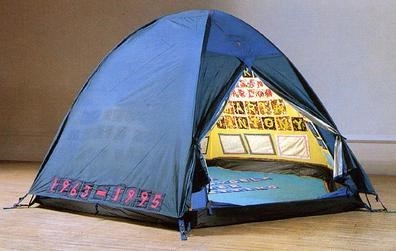
Tracey Emin, Everyone I Have Ever Slept With (1995)
https://bilderfahrzeuge.hypotheses.org/3437

Tracey Emin, Why I Never Became a Dancer (1995)
https://www.artforum.com/video/tracey-emin-why-i-never-became-a-dancer-1995-49262
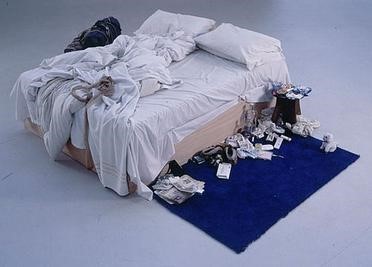
Tracey Emin, My Bed, (1999)
https://en.wikipedia.org/wiki/My_Bed
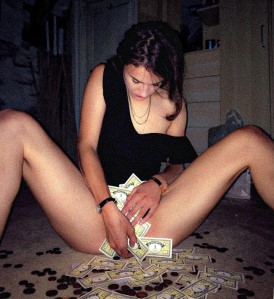
Tracey Emin, I've Got It All (2000)
https://www.theartstory.org/artist/emin-tracey/artworks/#pnt_4
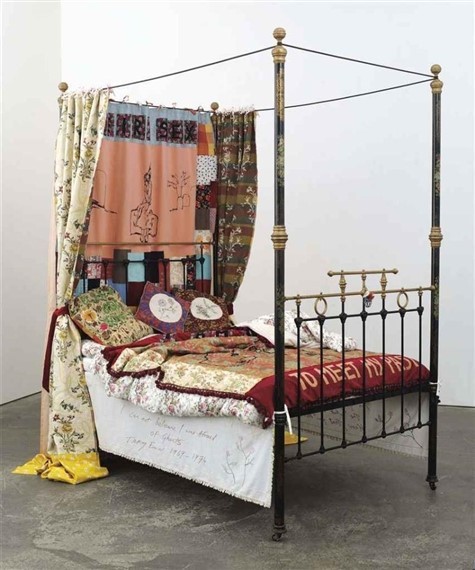
Tracey Emin, To Meet My Past (2002)
https://www.christies.com/en/lot/lot-5709375
Childhood
Tracey Emin was born in Surrey, in England. She grew up in Margate, on the coast of Kent, with her twin brother Paul. She lived with her mother in a successful seaside hotel, where she claims she was treated "like a princess." Her Turkish father lived with them for half of the week, spending the other half with his wife and other children. After a few years, Emin's father left and took his money with him, leaving Emin's mother bankrupt.
The family was then forced to live in poverty; Emin later recalled that they had two meters, one for gas and one for electricity, but they could never afford to have them both on at the same time. When she was 13, Emin was raped; something that she later claimed, "happened to a lot of girls."
Early Training and Work
Emin left Margate to study fashion at the Medway College of Design between 1980 and 1982. She met the avant-garde personality Billy Childish, who was also a student at the college until he was expelled. Her relationship with the colourful writer, their work at Childish's small press, and her study of printing in Maidstone Art College, are all what Emin considers important artistic experiences in her maturing as an artist.
In 1987, Emin's relationship with Childish ended and she moved to London. She studied for an MA in painting at the Royal College of Art, which she received in 1989. However, after leaving the college she went through an emotionally traumatic period in which she had two abortions, and this experience caused her to destroy all the work she had made at the Royal College.
While she was still coming to terms with her own artistic practice, she influenced a reactive movement called Stuckism, which sought to promote figurative painting rather than the sort of conceptual art that Emin was focused on at the time. It was founded in 1999 by Emin's ex-boyfriend Billy Childish. The movement's name was inspired by Emin, when she had told Childish his paintings were "Stuck! Stuck! Stuck!"
In the years after breaking up with Childish, once Emin rose into fame, he became very vocal about Emin's art practice. He opposed the art business and in turn the popularity of her work and said, "Taking cultural things and turning them into mere commerce is very dangerous. Professional football has ruined football and professional art has ruined art. A decadence and superficiality have set in and sometimes I wonder if maybe we have got what we deserve. I think it is odd that the Brit artists cite the influence of someone like Duchamp who was involved in anti-art and who was taking the piss out of the pompous pretentious art establishment. The biggest irony is that now they are that pretentious art establishment themselves, yet they still put forward this idea that they are undermining something." Childish's own Stuckism movement is more about rejecting the frenzy of conceptual art and sought to champion the work of figurative painters. The Stuckism movement is still quite active and is famous for protesting the Turner Prize every year to show their continued opposition. The Stuckism art movement is an action against artists such as Emin, and yet her artistic presence is the basis for their fundamentals, for their movement would not exist without Emin. She inspired the movement not only through her criticism of Childish's work, but also through her artwork and the public acceptance of her work. They may be in opposition to her but require her brand of art fame to continue their plight.
Mature Period
Upon moving to London, Emin become friendly with many of the other artists who would later be called the Young British Artists, which included Sarah Lucas and Damien Hirst. The group began to exhibit together in 1988, although Emin did not join ranks with them artistically until the early 1990s. The gallerist Charles Saatchi was a supporter and collector of the artists from the beginning of their careers and is often given credit for "discovering" them. The name of the group was from the title of an exhibition at Saatchi's gallery in March 1992 titled "Young British Artists I" but it was artist and writer Michael Corris who referred to the group of artists with that title in an ArtForum article in May 1992. Often all artists of that generation from Britain are called YBAs as it now holds a historic reference.
In 1993, Emin joined with Sarah Lucas to open a shop called "The Shop" in Bethnal Green, which was in the East End of London. They sold work by both artists, including anything from t-shirts to ash trays, to paper mache sex toys to dresses, adding a previously little-seen commercialism to their artistic practices, which would become a defining feature of Young British Art.
Emin had her first solo exhibition at London's White Cube in the same year. Named My Major Retrospective, Emin drew together a collection of personal items and photographs, creating a part-installation part-archive with a strongly autobiographical slant. This element of autobiography is key to her ongoing practice.
In the middle of the 1990s, Emin began a relationship with curator and art world figure Carl Freedman. Freedman was friendly with Damien Hirst and had worked with him on some of his important early shows that introduced Young British Art to the public. In 1994 the couple travelled in the US together, where Emin paid her way by doing readings. They also spent time in Whitstable on the Kent coast together, often using a beach hut that Emin purchased with her friend Sarah Lucas. She has spoken about how much she enjoyed owning property for the first time saying, "I was completely broke, and it was really brilliant, having your own property by the sea." In 1999 she later turned the hut into an artwork by bringing the structure from the beachfront into the Saatchi Gallery and calling the work, The Last Thing I Said to You is Don't Leave Me Here (1999).
In 1995, Freedman curated a show called "Minky Manky" for which he encouraged Emin to make artwork larger and less ephemeral. The result was her well-known work Everyone I Have Ever Slept With 1963-1995 (1995), which was a tent embroidered with the names of everyone with whom she had shared a bed, sexual or otherwise. This artistic touch through words is a common theme throughout her work. Emin uses her own handwriting, as seen in her neon messages, embroidered words, monoprints and hand-cut letters for her applique designs. Misspellings and grammar mistakes are present in her artworks, as if to add humiliations and failures to her authenticity.
Emin first came to the attention of the wider British public when she appeared on a television show about the Turner Prize in 1997, where she was belligerent and drunk, swearing on live television among a panel of academics. She finished her appearance by saying, "I'm leaving now, I wanna be with my friends, I wanna be with my mum. I'm gonna phone her, and she's going to be embarrassed about this conversation, this is live, and I don't care. I don't give a fuck about it." She ended with, "you people aren't relating to me now, you've lost me" before taking off her lapel mic while still talking and walking off in the middle of the live show.
Two years after her drunken television appearance, Emin was nominated for the Turner Prize for her controversial work My Bed (1998). Only one British artist of the four nominated can win the prize, and Emin lost the Prize that year to Steve McQueen. The surrounding press coverage dubbed her the "bad girl of British art". At the time, many voiced opinions about the types of stains and impurities contained in her artwork, even the lowest English tabloids weighed in. Although she never won the Turner Prize (yet), it was the catalyst for her fame.
Her work evolved during this period and she developed a more specific style. Her choice to use needlework and applique techniques place her work within a tradition of feminist discourse within modern and contemporary art. These techniques were considered domestic handicrafts and were typically considered low in the hierarchy of art, and a part of normalized feminine practice - a concept that Feminist art has waged war against with significant success. Emin herself has no fear of being associated with "low art" or "women's work", for she embraces her own sexuality and femininity; and most certainly places importance upon it.
Current Practice
Emin's personal life and public appearances have become less sensational since the late 1990s. Her work is in a variety of important collections, and many celebrities have become collectors of her art, including Elton John and George Michael. She has also become friends with many famous people from the music and fashion worlds, including Ronnie Wood of the Rolling Stones, Vivian Westwood, Kate Moss, and Madonna. Madonna has described Emin as "intelligent and wounded and not afraid to expose herself."
In 2007, Emin was made a Royal Academician at London's Royal Academy of the Arts, marking her ascent into the upper echelons of British art society and her acceptance by the establishment. She was later also made a professor of drawing at the institution. In 2013, she was included on a list of the 100 most powerful women in the country by BBC Radio 4, and in the same year she was awarded a CBE for her services to the arts.
For the 52nd Venice Biennale in 2007 Emin was the second female British artist to be nominated to represent the British Pavilion (the first was Rachel Whiteread in 1997). She exhibited a work titled, Borrowed Light which featured many of her early drawings alongside her recent works. The show received mixed critique, and she was criticized for being limited in her art practice.
In 2015, Emin took the unusual decision to "get married" to a rock in her garden in France. She later stated that "somewhere on a hill facing the sea, there is a very beautiful ancient stone, and it's not going anywhere," describing her rock-husband as "an anchor, something I can identify with." She symbolically chose to wear her father's funeral shroud for the short and unconventional ceremony. This is to be understood as a universal expression of love, and an expression of the soul or the invisible self. Emin has announced numerous times that she no longer has sex and is not invested in physical conquest, but rather, seeks to focus on love and her work.
The Legacy of Tracey Emin
Emin's work as part of the Young British Artists movement placed her firmly within a key legacy that was to affect the development of art in Britain for years to come. Similarly, she holds an international stage, for her work tackles universal ideas through her relationship to human behaviour and gender. Her seminal work My Bed helped redefine what a liberated woman can be. Emin’s work influenced a generation of female artists who explore womanhood and feminism through a self-confessional tone. These include artists such as Marie Jacotey-Voyatzis, whose print works explore her emotional life as a woman and include Emin-like misspellings, and Laure Prouvost, a Turner Prize winner who works with self-revelatory video as well as textiles and found objects to create striking tableaux. Emin has evaded aligning her ideology with a larger political cause, and has stated, "I'm not happy being a feminist. It should all be over by now."
Her work can be understood as belonging to the ethos of third-wave feminism; a belief that a woman can define her sexuality on her own terms. The lack of symbology in Emin's work forces audiences to focus on the real and often taboo aspects of femininity through modern women's issues, such as menstruation, abortion, promiscuity, and the shame associated with these topics. She has carved her own place and continues to produce artwork with her signature strong, yet vulnerable edge.
Emin continues to be active in her art practice, and the basis of her work remains tied to physical identity through corporeal and spiritual anguish. She is an active participant in her artwork, and through this she lends an openness and vulnerability to her audience through universal emotion. She rejects discussion of the feminist authority in her work, and yet she engages directly with modern female identity. Art allows the violation of social norms, and in turn a way for viewers to enter sharing the human social condition - often in a controlled environment.
2 notes
·
View notes
Photo

Translated interview (with omissions)
The female gaze: An interview with Céline Sciamma
Michael Ranze, filmdienst.de, 2nd of November 2019
// Additions or clarifications for translating purposes are denoted as [T: …]. A couple of omissions in the first interview, but I provided links to existing articles with more information. I’ve also added extracts from two more interviews with Céline below. Aaaaand... I believe this is it for German Portrait interviews! 😅 //
A conversation with the French director about ‘Portrait of a Lady on Fire’.
The French director Céline Sciamma already garnered international attention with her debut film ‘Water Lilies’. She is now a regular at the big film festivals. Her recent film ‘Portrait of a Lady on Fire’ is a multi-layered love story between a female painter and a young noble woman, whom she has to paint.
Interviewer: Your first three films ‘Water Lilies’ (2007), ‘Tomboy’ (2011) and ‘Girlhood' (2014) are about the coming-of-age of female characters, about their search for identity, including sexual identity. Where does this great interest in the world view of young women come from?
Céline Sciamma: I was lucky enough to make films as a young woman and to talk about things that I know about and understand. That’s why my first three films were closely connected to the childhood and youth of the heroines, and their female identity. I’m also pursuing the same theme in my new film ‘Portrait of a Lady on Fire’, this time with grown women. In the other films there was always the desire for love, which is also self-discovery. Love is fully lived out this time – this creates some kind of dialogue. I am 40 years old – I now have to talk about these things. (laughs) [T: Also see here, here, here or here about her previous films]
I: But there’s also the theme of female solidarity, especially in ‘Girlhood’…
CS: Yes, indeed. The more my work develops, the more it deals with the theme of friendship, sorority, but also the ability to enjoy life to the fullest. This also includes solidarity, these small islands that women can establish together. My films open up the space for this idea, this is much more radical in ‘Portrait of a Lady on Fire’ than in my previous films.
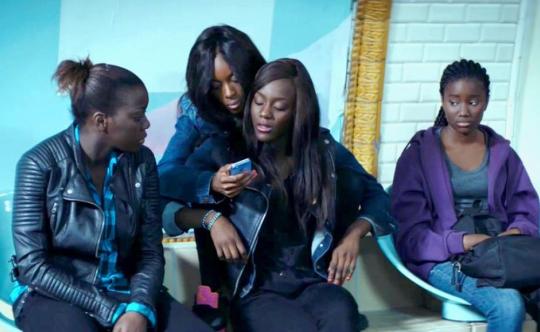
I: But you also wrote the screenplay for André Téchiné’s film ‘Being 17’, where the two main characters are adolescent boys.
CS: That’s the same kind of work for me. It’s about creating characters without objectifying them, and to find access to their experiences. The female gaze is not only about filming women. It’s also about being aware about the images and representations. You have to pay a lot of attention, when you are inventing or composing something. Otherwise it becomes conventional, or you create characters that are empty. That applies to men and women. The male gaze is damaging for male representation in my opinion. I thought that it would be interesting for me to do it differently.
I: How did you work together with André Téchiné on the screenplay?
CS: This was the only time in my career as scriptwriter that I worked on the script with someone else. I admire Téchiné’s work. My first cinephile emotions are linked to his films. It was therefore a lot of fun to enter his matrix and get access to his thinking, on the one hand to participate, and on the other hand to support his goals. The fact that he wanted to do a film about youth motivated me to make him a young film director. [T: Also see here about her work on ‘Being 17′]
I: He is now 76 years old.
CS: Yes, exactly. He was 73, when we worked together. But it never felt like there was a huge age hierarchy between us. I admire him very much, he really fuelled my ambitions, we have a very intense relationship.
I: What do you like more: writing scripts or directing films?
CS: This has changed. I always liked the balance between the two, also the fact that I didn’t always have to follow my own wishes, but could immerse myself in another logic and worlds, and distract myself. But over the years I realised that I don’t want to lose any more time. It’s of course not a waste of time to work for others. But you sometimes have to put up with long project delays. For the first time in a long time I don’t have any screenplay assignments, and I like this feeling. But you never know what may happen. I was really blessed with some projects. For ‘My Life as a Courgette’, it just gave me joy to write a film for children. If something like that comes along again, I would do it immediately. [T: Also see here about her work on ‘My Life as a Courgette’]

[T: Omitted Q&A about the reasons why she did a period film, but see here, here or here]
I: What are the challenges when you recreate a period, which was so long ago?
CS: You have to do a lot of research, especially about the situation of female artists. You really have to dig deep, because no one wrote a thick book on it. The other challenge was the collaboration with others. That is the beauty of cinema. The costume designer does research about that period, so does the set designer. This is my third collaboration with Thomas Grézaud (he also worked with Sciamma on ‘Girlhood’ and ‘Tomboy’, editor’s note). He always suggests something, which is then incorporated into the film. When it is about historic films, then accuracy is very important. But sometimes it’s also interesting to consider what is not in the picture. For example, there is not much furniture. We built the few pieces ourselves, out of wood and with cotton. It was more about believing in cinema, in action, in clear lines.
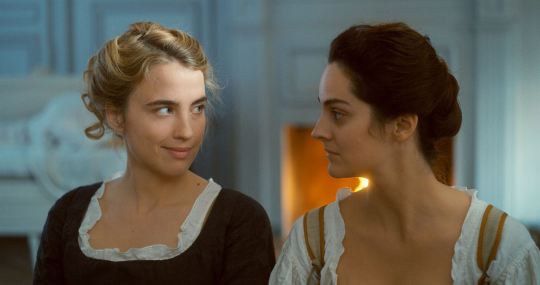
I: So you work closely with the costume and set designer?
CS: Yes, there is a close coordination. I wanted some kind of uniform for the characters, for example. We then looked at various costumes. They were not supposed to be out of silk but rather heavy fabrics, which restrain the actresses, force them into their roles and at the same time describe the sociology of their characters. I also wanted pockets for the costume of the female painter, even though others told me it would be anachronistic or too modern. Fact is that pockets existed back then and that they vanished in the 19th century. The ‘femme bourgeoise’ [T: middle-class woman] was invented, and fashion went backwards. I liked the idea of this silhouette, which was even accurate. That is our job: We try to give a presence to these women from back then.
[T: Omitted Q&A about how the actresses were recruited, it mentions the circulation of gazes between the three, the physical and psychological contrast between Adèle and Noémie, Céline describes them both as strong, intense, determined and courageous actresses, she also wanted to create an iconic and fresh couple; see here or here]
I: You spoke about the ‘circulation of gazes’. Between the actresses there are short and long gazes, shy and curious ones. How did you conceptualise this ‘ballet of gazes’?
CS: That was already in the script, especially the rhythm of the gazes, when they look at each other. The actresses were very much aware about that. It’s not about dictating what they have to do. But it’s rather a way to start the conversation, to show their connection or communicate their intentions. They have to ‘dance’. I call it a collection of gazes. As you already said: We have this gaze, we have that gaze. It changes with every scene. And it shows how good the actresses are. If it’s in the script, then the actresses are very, very good [T: this was weirdly worded]. Otherwise they might suggest something that doesn’t fit. You have to see straight away that they desire each other. And it’s brilliant how they do it.
I: I liked the beginning of the film, when Marianne jumps out of the boat to retrieve her large case. A woman isn’t supposed to do that, so it shows that Marianne is different than others…
CS: And the film also shows that: She is not a woman who follows the rules. She jumps into the water to get her things. The important thing is: The film also jumps into the water. The camera also dives in, we swim with her. That’s two pieces of information: This character will be an active one, and the film will join this jump. [T: Also see here]
I: There are only women on the island…
CS: No – we just don’t show the men.
I: The island seems like a refuge or even a utopia.
CS: Yes – that’s true. In cinema, it is about what you decide to show in the picture. I didn’t want to show men, because then it would have been about the pressure and dominance that existed back then and still does. We now look at what is possible, at the potential of the women. You can also call it utopia, but these are not imaginary futuristic dreams, it is based on life experiences, maybe on a higher level, if it was more based on reciprocity. And political utopia – there has to be a place, where the economy doesn’t determine everything, where there is no sexism or racism. These places exist, in families, communities, maybe in a city. This culture has to grow. This utopia arises from experiences that we make and transform to ideas.
[T: Omitted Q&A about the cinematography of Portrait, but see here or here]
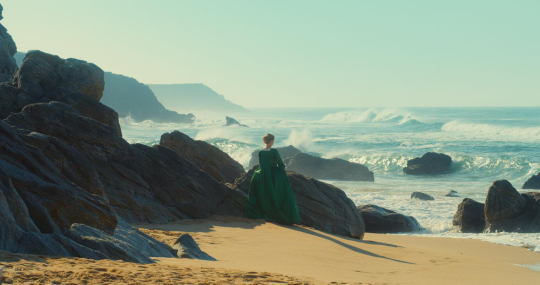
—
Interview with director Céline Sciamma (extracts)
Sportello745, moviebreak.de, 9th of October 2019
[…] Interviewer: In your debut film ‘Water Lilies’ you contrast the uncontainable, awakening hormones of the main character with a perfectly synchronised swimming team. In which way does the landscape characterise the emotions in your new film?
Céline Sciamma: In Water Lilies, it was about what’s on the surface and what’s hidden below. I guess, even with synchronised swimming it’s less about control but more about what you don’t see and the effort you have to make underneath. I don’t think I rely on symbolism too much, I get often asked about the meaning of, for example, colours. That’s not really how I think, I try to embody certain things and be less metaphoric. But maybe in this film the tension is between love and art and beauty. The landscape does fit into this tension very much. [T: Also see here or here for Water Lilies]
I: Did the paintings that you researched have any influence on the language of the film, and if yes, which paintings in particular?
CS: Yes, they did. It was especially the self portraits of female painters, because these pictures were quite different from what you would expect. There was a specific painting, which was actually not from the 18th century but from the 17th century, it was from a woman called Judith Leyster, a [T: Dutch; also see here]. Her work was misattributed to her husband. In the picture, you can see her painting, she smiles, you can see her teeth. I have never seen something like that. It helped me to be courageous, which means it made us invent something new and not be scared of being unconventional. That is exactly the kind of female contribution to art history: When Virginia Woolf writes, she reinvents literature, she revolutionises it [T: also see here or here]. When Chantal Akerman films ‘Jeanne Dielman’, it is a revolution for cinema [T: also see here, here or here]. The voices of women are not only limited to ‘Hey, we have a little story to tell’, but it is always about reinventing art. It is about creating something new instead of the same old. […]

I: When did Marianne paint the eponymous ‘Portrait of a Lady on Fire’ in your opinion, shortly after her encounter on the island or many years later?
CS: I think, she painted it a couple of years later. That is her memory. When I commissioned the painting, I originally wanted to have 20 frames, maybe even that Marianne’s whole work is based on this moment. A kind of ‘usual suspects’ situation, where everyone reappears. But this moment [T: at the bonfire] is definitely the matrix for what she will do next, and I think, [T: the painting] was made years later […].
I: At the end of the film the love story between the two is ‘concluded’. On the one hand, the ending is bittersweet, because the love has been immortalised in a painting. On the other hand, it is also quite sad, we see Héloïse crying. It felt as if this great piece of art, which tells the story of the two women, can never be exchanged for the love that was lost. What do you think?
CS: We tried to spark a dynamic where the end of the love story doesn’t mean that they spend eternity together or die. It was about getting rid of the sentiment that the victory of love is mutual possession. Their love for each other made them curious about love itself and art. For me, the last scene addresses how art deeply affects us and how love makes us more emotional towards beauty. […] At the end, Héloïse feels the music she would never have felt if she had not loved. Love as curation for being curious about the future, about art, about beauty. That for me is a positive dynamic, even though it is heartbreaking, which was on purpose. At the end, both women are more open, and that is the dynamic of emancipation, which I love. And it is positive to talk about it.
—
Sciamma: ‘I want to show images of daily life that are missing’ (extracts)
Patricia Batlle, NDR.de, 29th of October 2019

Interviewer: You had a very lively screening of your film ‘Portrait of a Lady on Fire’. There were standing ovations from the audience, and there was an animated conversation with you and the lead actresses Adèle Haenel and Noémie Merlant. Were you surprised to be so warmly welcomed in Northern Germany?
Céline Sciamma: It’s funny because you are sometimes cautioned that other countries have a less welcoming culture, but not to take it personally. So you prepare for different types of audiences. But then the reception in Hamburg was really, really warm. It doesn’t surprise me, because I believe that film is a nation, that film culture is unique and unites the viewers [T: PORTRAIT NATION FTW]. A cinema is sometimes like a country. I travel around a lot with the film and I feel the warmth, this fire in the cinema across countries. […]
I: You address topics like menstruation and abortion that are rarely shown in cinema – especially not in love films.
CS: Yes, why is that? That is crazy! This clearly is part of the pleasure of the film, part of its political intention. To show images that are missing, although these are images of daily life. Our story should put our audience on an emotional rollercoaster, where the images have an unusual relationship with the story and are surprising. That is the power of new images.
I: Four women play an important role in your film, men are on the sideline. The names of the women stand out all the more. The self-confident painter is called Marianne. The name is synonymous for the Republic of France – was this on purpose?
CS: I have to admit: I didn’t think about that. I didn’t think about the Marianne of the Republic, when I wrote the script. The names of all my characters are related. In my debut film ‘Water Lilies’ my main character was called Marie, in ‘Girlhood’ she was called Marieme, and here she is called Marianne. It’s like a thread that runs from film to film. But it’s true: It is France! I like the fact that you noticed this. (laughs) […]
—
Articles:
https://www.filmdienst.de/artikel/38732/interview-celine-sciamma-zu-portrat-einer-jungen-frau-in-flammen
https://www.moviebreak.de/features/interview-mit-regisseurin-celine-sciamma/item?item=2
https://www.ndr.de/kultur/film/Sciamma-ueber-Portraet-einer-jungen-Frau-in-Flammen,frauinflammen106.html
Picture sources: [1], [2]
#Filmdienst.de#moviebreak.de#NDR.de#Céline Sciamma#Portrait of a Lady on Fire#October-November 2019#German interview#These were the remaining Portrait interviews#in German#That's that#Time well spent#My translation#long post
74 notes
·
View notes